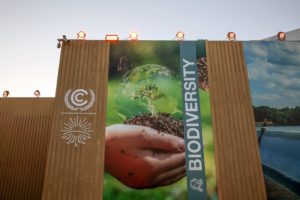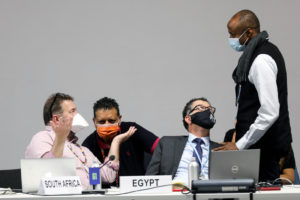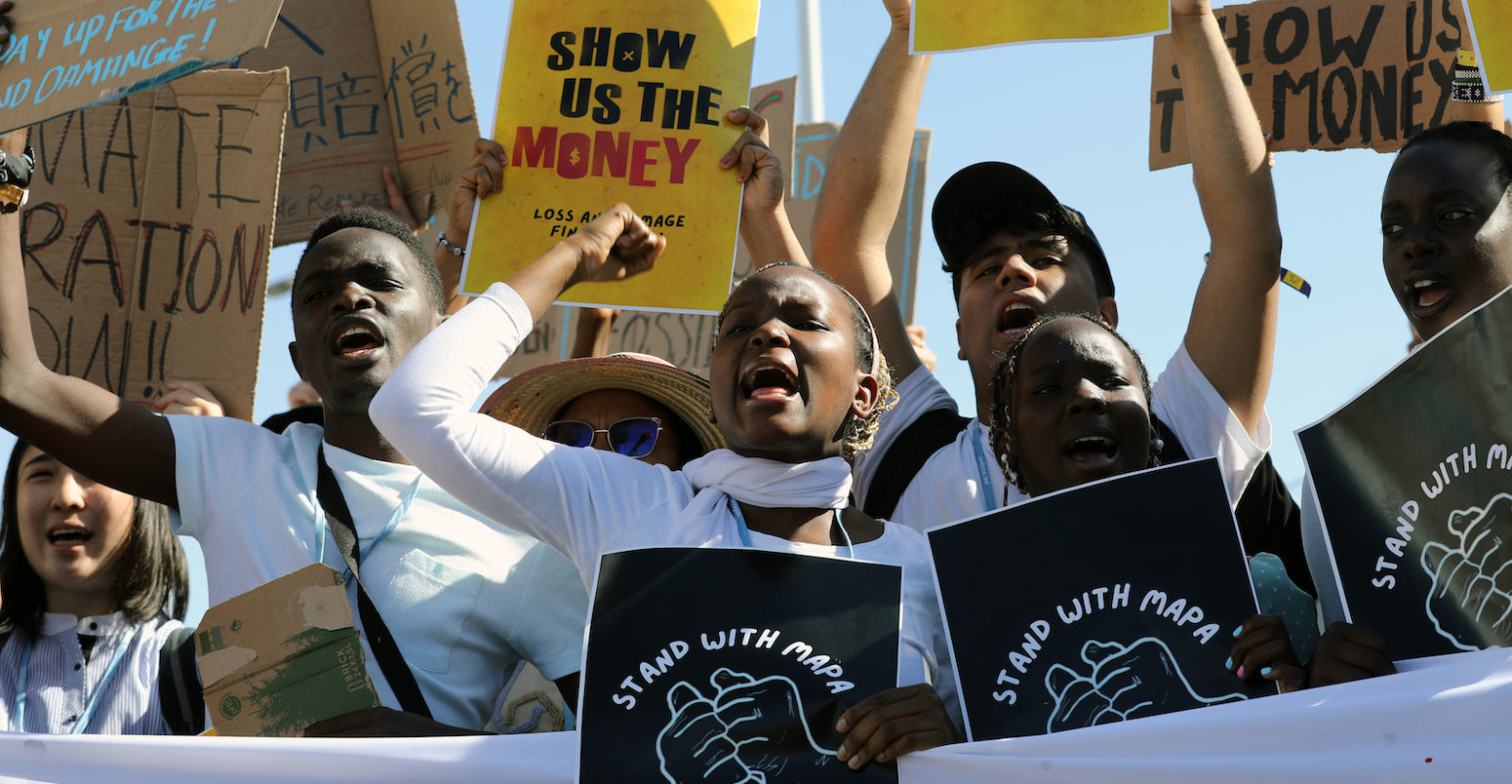
COP27: Key outcomes agreed at the UN climate talks in Sharm el-Sheikh
Carbon Brief Staff
11.21.22Carbon Brief Staff
21.11.2022 | 1:54pmThe COP27 summit in the Egyptian resort town of Sharm el-Sheikh made history when developing countries secured a new fund to support the victims of climate disasters.
Yet this was tempered by a wider agreement – the “Sharm el-Sheikh implementation plan” – that excluded any mention of winding down the use of fossil fuels. It also provided little indication that nations were serious about scaling up efforts to cut emissions.
Talks at the second most attended COP of all time went deep into extra time, as parties attempted to reach a deal that could secure consensus.
The Egyptian presidency had promised an “implementation COP” that would see the pledges of the past give way to balanced action on tackling climate change and preparing for its effects.
In reality, the results were a mixed bag, achieving more on the impacts of climate change than on its causes.
The decision to set up a new fund for “loss and damage” resulting from climate change marked the climax of a decades-long effort by small island states and other vulnerable nations.
But the EU and its allies voiced strong concerns about an outcome that did little to advance efforts to stay below 1.5C, beyond what had been agreed at COP26 in Glasgow last year.
All of this took place against a backdrop of overlapping global food, energy and debt crises, and an Egyptian government facing accusations of human-rights abuses.
For the first time in UN history, protesters were allowed to march inside the venue, avoiding the attention of the host nation’s security forces.
Here, Carbon Brief provides in-depth analysis of all the key outcomes in Sharm el-Sheikh – both inside and outside the COP.
Formal negotiations
Egyptian leadership
At the start of COP27, COP26 president Alok Sharma officially handed over proceedings to Egypt, the world’s largest Arab nation and the first African country to host a climate summit since Morocco in 2016.
This morning I formally opened #COP27 🇪🇬 🇺🇳 and brought the 🇬🇧 COP Presidency to a close
— Alok Sharma (@AlokSharma_RDG) November 6, 2022
I fully recognise the scale of the challenge ahead but I remain hopeful
We know what we need to do and how to do it – now, it is time to deliver
Read the speech👇https://t.co/jiVAhAeS1I pic.twitter.com/wItevlG0d0
Ahead of the conference, Egypt made it clear that it wanted COP27 to be all about “implementation” – putting plans for tackling climate change into action.
This sentiment was echoed by incoming UN climate chief Simon Stiell, who said he would be “holding people to account” for the promises they had made.
At a press briefing held a few days before the summit, ambassador Mohamed Nasr, Egypt’s lead negotiator and director general for climate at the Egyptian ministry of foreign affairs, told journalists:
“Science reports were telling us that, yes, planning is not up to expectations, but it was the implementation on the ground that was really lagging behind. This is why the presidency was very clear [on implementation].
“Moving on in 2022, we have a geopolitical situation that is having a negative impact on things. We’re having an energy crisis, a food crisis, a finance crisis, a debt crisis – and over and above we have a climate impacts crisis. Floods in Pakistan, Nigeria, forest fires in Europe, hurricanes in the US. Climate change isn’t giving us space to breathe.”
These challenges all helped to shape Egypt’s approach to hosting COP27, he added.
Egypt decided to follow the UK in holding a world leaders summit at the start of the conference to ensure “that the political commitment at the highest level of the international community is still there”, he said.
The host country also decided to hold six “high-level” roundtable discussions on topics related to current global challenges, he added. These topics were: food security; water security; finance; energy security and futures; vulnerable communities; and the need for a “just transition” away from fossil fuels.
112 world leaders gathered under the title “Together for Implementation” to discuss and deliberate how to further deliver on the global climate agenda and translate climate commitments into implementation. pic.twitter.com/anw3vfQFkQ
— COP27 (@COP27P) November 17, 2022
The focus on issues such as food and water security were particularly relevant for vulnerable communities in Africa, he added:
“The way we see it: this is a global challenge and the conference is happening on African soil.”
In addition to holding roundtables, the Egyptian presidency also split the conference into 11 “thematic days”, which were (in order): finance; science; youth and future generations; decarbonisation; adaptation and agriculture; gender; water; age and civil society; energy; biodiversity; and solutions.
Before the formal negotiations could begin, parties had to agree to the agenda for the meeting. After a mammoth “agenda fight” lasting more than 48 hours, parties agreed to include finance for the “loss and damage” caused by climate change.
This had been a key priority for many developing countries ahead of the summit. This is shown by Carbon Brief’s interactive ”who wants what at COP27” table of parties’ positions on key topics.
The formal agenda did not include issues pushed by some groups, including how to keep warming below 1.5C and how to align global financial flows with climate targets.
However, both matters were among those taken up by the Egyptian presidency, as part of its consultations towards the overarching “cover decision” from COP27.
Each day, the Egyptian presidency held press conferences to offer updates on announcements during the thematic days, as well as progress with the negotiations.
However, much of the time at these press conferences was taken up by questions over access and logistical issues, civil-society safety concerns and accusations of greenwashing at the summit (see the sections below).
In addition to these concerns, Egypt’s ability to guide the parties towards consensus also came under scrutiny in public and private briefings – particularly towards the end of the negotiations.
While the summit followed a similar pattern to other recent COPs, question marks over Egypt’s handling continued to surface. The first week saw technical negotiations under the “subsidiary bodies” of the UN climate regime, SBSTA and the SBI.
These talks overran, as they often do, but the number of unresolved agenda items might have been a record, according to one delegate quoted by the Earth Negotiations Bulletin.
In the second week, the presidency asked pairs of ministers to work on the most contentious topics, as listed in a table compiled by Carbon Brief.
Throughout the summit, Carbon Brief kept tabs on progress via a widely-used “text tracker”.
It’s halfway point at #COP27
— Simon Evans (@DrSimEvans) November 13, 2022
Where do things stand?
To help us (and you!) keep up, @CarbonBrief has made a free-to-use, colour-coded text tracker
It shows where negotiations are moving forward and where (in shades of red) disagreements remainhttps://t.co/sEYWJQHnJI pic.twitter.com/OrwPRq6CWL
(All COP27 decisions were subsequently published in a table on the UNFCCC website.)
Multiple observers and negotiators told Carbon Brief of organisational problems at COP27. These included positions not being reflected in negotiating text, negotiations discussing drafts not available on the UNFCCC website and delegations unable to hear due to noise.
On Thursday 17 November, Sharma, the EU’s climate chief Frans Timmermans and Canada’s environment and climate minister Steven Guilbeault paid COP27 host Sameh Shoukry a visit to express their concerns about progress on the negotiations, according to the UK.
UK, EU and Canada made 11th hour plea to #COP27 president Shoukry this morning to tell him “Last thing anyone wants is for this to end without consensus”
— Adam Vaughan (@adamvaughan_uk) November 17, 2022
.@AlokSharma_RDG for UK, @TimmermansEU for EU and @s_guilbeault for Canada
via spokesperson for COP26 presidency
Later that day, Shoukry also met with the UN secretary-general António Guterres. Shortly after, he released this statement:
“The COP27 presidency is working around the clock with facilitating-ministers to ensure a timely conclusion of all issues at hand. I urge all parties to go the extra mile, take the necessary steps to reach the much-needed conclusions and agreements. The world is waiting for us to demonstrate the seriousness by which we tackle this matter and, as a community of nations, we must live up to their expectations.”
COPs often appear unresolvable around the middle of the second week. As negotiations spilled into the weekend, however, conversations turned to the risk of ending without a deal.
COP27 eventually came to a close at 9.19am on Sunday 20 November, more than 39 hours later than planned. This is the second-longest overrun, after COP25 in Madrid in 2019.
COP27 was gaveled to a close at 9:19am this morning, just over 39 hours late pic.twitter.com/YbZheCmjnT
— Joe Goodman (@joejgoodman) November 20, 2022
Sharm el-Sheikh implementation plan
COP27 agreed an overarching “cover decision”, known as the Sharm el-Sheikh implementation plan, reusing language on 1.5C and phasing down coal from last year’s Glasgow Climate Pact.
The plan “requests” countries that have not yet done so to “revisit and strengthen” their 2030 climate targets by the end of 2023, “as necessary to align with the Paris Agreement”.
It makes first-ever mentions of food, “tipping points” and the need for financial system reform. Yet it failed to advance ambition on 1.5C and ignored growing calls for fossil fuel phaseout.
Dr Tedros Adhanom Ghebreyesus, director general of the World Health Organization, lamented the omission on Twitter: “lives will continue to be lost until fossil fuel addiction is taken care of”.
I welcome the inclusion of:
— Tedros Adhanom Ghebreyesus (@DrTedros) November 20, 2022
-Loss & Damage Fund
-food, youth, finance reform
-“the right to a clean, healthy & sustainable environment” as #ClimateAction guiding light in the #COP27 agreement. However, lives will continue to be lost until fossil fuel addiction is taken care of.
A few days before the event opened, COP27 president Sameh Shoukry had published an open letter on his hopes and expectations for the summit. He wrote:
“We aim to restore the ‘grand bargain’ at the centre of the Paris Agreement and our collective multilateral process – whereby developing countries agreed to increase their efforts to tackle a crisis for which they are far less responsible, in return for appropriate financial support and other means of implementation.”
UN secretary-general António Guterres used his opening remarks at COP27 to make a similar plea, calling for a “climate solidarity pact”. This would see “all countries make an extra effort to reduce emissions this decade in line with the 1.5C goal”, Guterres said.
In return, “wealthier countries and international financial institutions [would] provide financial and technical assistance to help emerging economies”.
Towards the end of the summit, EU climate chief Frans Timmermans played a similar tune. In briefings to the press and in a plenary speech, he said the EU would back a new fund for loss and damage. But he said this must go “hand-in-hand” with stronger efforts on 1.5C.
Yet despite threatening to “walk away” from a “bad decision” and warning “we cannot accept that 1.5C dies here and today”, the EU ultimately – if reluctantly – backed a deal.
There were two reasons for the EU’s disappointment. First, it had called for a more ambitious “mitigation work programme” that went beyond the Glasgow “baseline” (see below). Second, it had backed the call from India for all fossil fuels to be phased down.
At COP26, parties had endorsed a call to “phase down” unabated coal power. In Egypt, India repeated its view that this should be extended to all fossil fuels, not just coal.
Yet despite growing support from around 80 countries including the US, Canada, Australia, small island states and Latin America, the Egyptian presidency effectively stonewalled.
Catherine Abreu, executive director of Destination Zero, told Carbon Brief:
“Parties asked for it pretty consistently. More and more parties [joined the call] with every consultation. Their ask for all fossil fuels to be included in the text was ignored every time…The presidency chose not to put those phrases into the drafts.”
Fossil fuel phase down (or phase out) was conspicuously absent in each successive draft of the cover decision, even including the text that Egypt said was a compilation of parties’ views.
Word from inside the heads of delegation meeting at #COP27 is that the Saudis and Russians are still saying any inclusion in text about fossil fuels is a red line.
— Leo Hickman (@LeoHickman) November 19, 2022
Russia: “Unacceptable…We cannot make the energy situation worse”
Presumably said without any sense of irony…
The final text once again left out fossil fuel phase down or out. Instead, it swapped mentions of renewable energy for language referring to “low-emission and renewable energy”.
(In the aftermath of the deal, there was speculation that “low-emission” might be intended as a “loophole” for gas, perhaps as a sop to Egypt’s gas-producing neighbours. Notably, however, the Glasgow pact had already used the term “low-emission energy” a year earlier.)
At one stage, there were even question marks over whether COP27 would row back on the Glasgow push for 1.5C. Some parties said they wanted to revert to the language in the Paris Agreement, which aims for “well-below 2C”, leaving 1.5C as a looser aspiration.
Animation by Tom Prater for Carbon Brief.This fight was resolved in the second week at COP27, after the G20 meeting in Bali, Indonesia, where presidents Xi Jinping of China and Joe Biden of the US met again for the first time, after a thaw in relations (see below). The G20 also agreed on a joint communique repeating the language of the Glasgow pact on 1.5C and phasing down coal.
Here are the key sections of new G20 communique that reference climate change, COP27 and coal – and also COP15 and biodiversity
— Leo Hickman (@LeoHickman) November 16, 2022
“We resolve to pursue efforts to limit the temp increase to 1.5C. This will require meaningful and effective actions/commitments by all countries” pic.twitter.com/auECC4cUDD
The UK’s outgoing COP26 president Alok Sharma said it had been a “battle” to “hold the line” on 1.5C set in Glasgow. In closing remarks at COP27, Sharma said:
“Many of us came here to safeguard the outcomes that we secured in Glasgow, and to go further still…[We] have had to fight relentlessly to hold the line…But we also wanted to take a definitive steps forward.
“We joined with many parties to propose a number of measures that would have contributed to this. Emissions peaking before 2025, as the science tells us is necessary. Not in this text. Clear follow-through on the phase down of coal. Not in this text. A clear commitment to phase out all fossil fuels. Not in this text. And the energy text, weakened, in the final minutes.”
Nevertheless, the Sharm el-Sheikh implementation plan did mark a number of notable firsts:
- For the first time, a COP cover decision mentioned food, rivers, nature-based solutions, tipping points and the right to a healthy environment.
- It noted the need for “transformation of the financial system and its structures”, calling on multilateral development banks and international financial institutions to reform their practices and priorities to address the “global climate emergency”.
- It launched the “Sharm el-Sheikh dialogue” on Article 2.1c of the Paris Agreement, which says “financial flows” should be aligned with global temperature targets.
- It also launched a “work programme on just transition”, including annual “high-level ministerial round tables”, with the first taking place at COP28 next year.
The plan also “welcomes” the latest IPCC report and the recommendations of the high-level expert group on net-zero, widely seen as an anti-greenwashing charter (see below). The plan does not mention the upcoming COP15 biodiversity summit (see below).
It makes only two brief references to Africa, the Earth Negotiations Bulletin summary of COP27 notes, despite having being billed as an “African COP”.
At a press briefing on Monday 14 November, Wael Aboulmagd, special representative for the COP27 presidency, had already started playing down expectations for the cover text.
Aboulmagd told journalists: “I think cover decisions will come out only if parties feel comfortable with them. We can’t impose our own vision for it.”
(The COP26 presidency had taken a different approach, see below.)
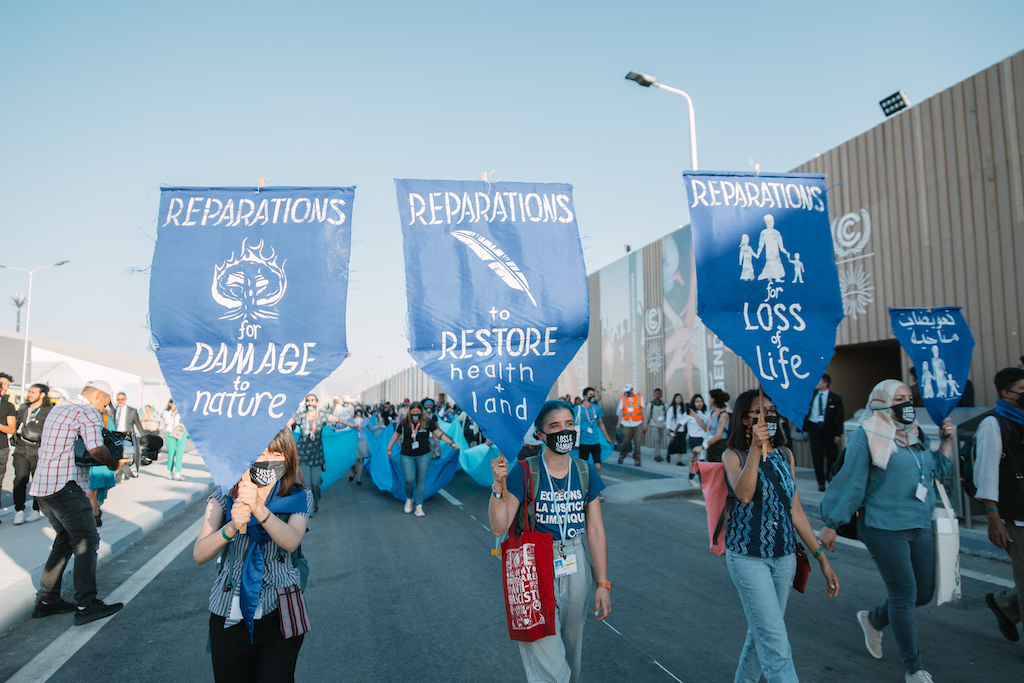
Aboulmagd noted that at a meeting with heads of delegations, parties expressed “two extremes” regarding the need for and appropriateness of a political cover decision.
According to Aboulmagd, some parties were asking “why does this practice exist at all, there should be no cover decisions”. At the other extreme, he said, were those asking for the cover decisions to be “even longer and more detailed than in Glasgow”.
This was a “red herring”, said Kaveh Guilanpour, a former negotiator and now vice president for international strategies at the Center for Climate and Energy Solutions (C2ES).
He told Carbon Brief that since all COPs have cover decisions, it is the political nature of recent outcomes that has ruffled feathers. Guilanpour explained:
“Cover decisions have taken on a life of their own as the COP process attempts to respond to the world with political signals on ambition. COPs are not set up to deliver ambition through the negotiations, which will need to become increasingly technical as we pivot to implementation in the post-Paris era.”
You will hear a LOT over coming days about the “cover decision” texts coming out of #COP27
— Leo Hickman (@LeoHickman) November 17, 2022
These are the all-important political commitments agreed by all nations.
I’ve been looking back at history of these texts since COP1, as they have grown in significance
…and size pic.twitter.com/2tukmHMItb
As former SBSTA chair Paul Watkinson told Carbon Brief last year, COP25 in Madrid was the first to have “purely a political overview decision, including points that needed a home which did not exist elsewhere”. The Glasgow pact at COP26 had taken this “a lot further”, he said.
The outcomes – and omissions – from the Sharm el-Sheikh “implementation plan” illustrate some of the issues with this presidency-led process, which is “less transparent [and] less inclusive” than formal negotiations.
The way the Egyptian presidency developed the cover decisions at COP27 was also rather different to the approach of the British COP26 presidency.
The UK presidency kicked off consultations on its priorities for COP26 in July 2021, months ahead of the summit, sharing a series of presidency notes with parties throughout the year.
It began consulting parties on their views about the cover decision in the first week of the summit, before releasing a summary of potential “elements” of the text early on Sunday.
In contrast, the Egyptian presidency only started consultations on the middle Saturday of COP27, releasing a very brief list of potential “elements” on the second Tuesday.
#COP27 latest
— Simon Evans (@DrSimEvans) November 10, 2022
Per presidency, consultations on all-important “cover decision” won’t start until Sat
Last yr cover text = Glasgow Climate Pact, inc coal phase down, call for stronger pledges, promise to double adaptation $$ etc…
…what will it say this yr?
(HT @daisydunnesci) pic.twitter.com/Rd4pbmFhoU
On the second Thursday of COP27, the Egyptian presidency released a much longer list of cover text “elements”, which remained far from a formal first draft. This was reportedly a compilation of ideas submitted by parties, rather than suggestions made by the Egyptians.
The first full draft in Sharm el-Sheikh did not arrive until the final Friday of the summit. A second draft came on Saturday 19 November, with the talks already in overtime. The final draft of the COP27 cover text was published shortly after 4am, on Sunday 20 November.
Why did #COP27 finish so late?
— Simon Evans (@DrSimEvans) November 20, 2022
This “cover decision” timeline probably didn’t help: pic.twitter.com/haQsUTgZNO
This contrasts again with COP26, where a full draft was released on the second Wednesday, followed by further drafts on Friday 12 and Saturday 13 November 2021.
Loss and damage
More than three decades after it was first proposed by small-island nations, COP27 was the moment when parties finally agreed on a new fund to provide money for “loss and damage”.
For years, UN discussions on the loss and damage resulting from climate change have remained highly technical. This is a far cry from the deadly and costly real-world impacts of the climate disasters they are supposed to address.
UN climate chief Simon Stiell, who was an advocate for loss-and-damage finance in his previous role as Grenadian environment minister, made it clear at the start of the event that there was appetite for progress, stating “the time has come” to “credibly” address the issue.
For years, developing countries have accused developed nations of blocking progress on money for loss and damage, an idea sometimes framed as “climate reparations”.
Wealthy, global-north countries, such as the US, have made it clear they do not want to be forced to pay compensation for their considerable share of historical emissions.
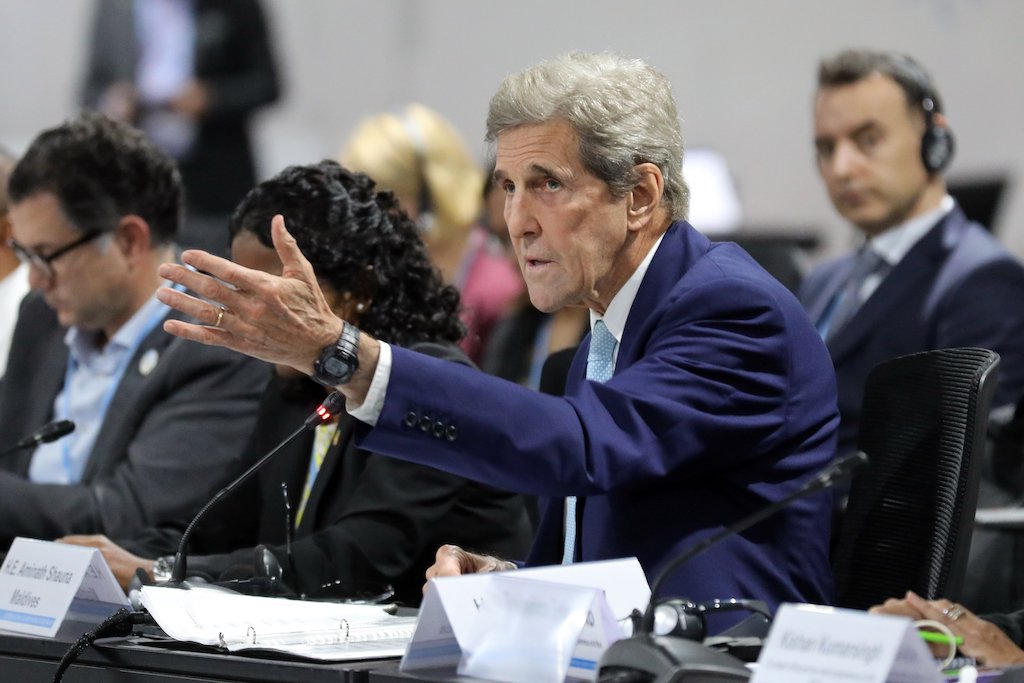
This came to a head last year when a push by the UN negotiating bloc known as “G77 plus China” (which actually represents more than 130 nations) for a “loss and damage finance facility” at COP26 was opposed by developed parties, including the EU and US.
During a year that has seen extreme events from the flooding in Pakistan through to the drought in east Africa, this implied opposition to helping those in need had prompted criticism.
Developed countries, therefore, came to COP27 on the defensive, eager to show that they did, in fact, support action on loss and damage. Even the US, long considered the main blocker of such action, said it was open to discussions.
In an early press conference, EU negotiator Jacob Werksman stated emphatically that his party had “never blocked a mention of loss and damage in any document that I’m aware of”. He also acknowledged the bloc’s historical responsibility for climate change, explaining:
“We have no difficulty talking about our willingness to support vulnerable countries suffering from loss and damage. We don’t do that under a legal theory of compensation or reparations. We do it because we think it’s the right thing to do.”
This apparent convergence between developed and developing countries was reflected in the conference agenda.
For the first time, it included an item to discuss “funding arrangements responding to loss and damage”. This came after an “agenda fight” between parties before the COP began that went on until the early hours of the first Sunday morning.
For the first time ever in UN climate negotiations #LossAndDamage finance has made it onto the agenda at #COP27
— Josh Gabbatiss (@Josh_Gabbatiss) November 6, 2022
This is a historic moment.
Small island nations have been raising this issue for 30+ years, and now it has happened after a concerted push from developing countries pic.twitter.com/WJXwNsNhqZ
Alliance of Small Island States (AOSIS) lead negotiator Conrod Hunte told Carbon Brief that, while there was some disagreement about the title and function, “everyone agreed” on the need for an agenda item.
That said, the Egyptian presidency noted as the conference opened that the outcome would be “based on cooperation and facilitation” rather than “liability or compensation”.
This was understood to be a concession to reassure developed countries. It also echoes the COP21 “decision text” that accompanied the Paris Agreement. This said the Paris deal “does not involve or provide a basis for any liability or compensation”.
Over the course of the two-week conference, the central dispute was over what precisely this agenda item would lead to – and when. It soon became clear that many were willing to stake the success or failure of the summit on this issue.
G77 plus China was adamant that it wanted a new loss-and-damage finance facility or fund under the UN and established at the COP27 summit, with the details hashed out later.
Developed countries argued that there should be further discussion of a variety of funding options, potentially culminating in a new facility in 2024. This two-year timeline aligned with the Glasgow dialogue, a process set up at COP26 to discuss loss-and-damage finance.
When a rough text containing potential “elements” of the final decision was finally released at the start of week two, the two options for loss-and-damage finance showed a clear developed versus developing country split.

Despite saying they were open to discussions, the US reportedly remained opposed to a new loss-and-damage fund. US climate envoy John Kerry told the conference at the end of the first week that his nation still completely rejected a fund based on compensation. “That’s just not happening,” he said.
In the following days, developed country parties, including the EU, Canada, Norway and the UK, released statements explaining where they stood on the creation of a new fund.
While noting the urgency and offering sympathy, all of these documents made it clear they did not want a new fund set up at COP27. Some said doing so would take too long, citing the lengthy creation of the Green Climate Fund (GCF) and, therefore, proposed waiting even longer while more information was gathered.
Several countries have now laid out their views on loss and damage finance.
— Josh Gabbatiss (@Josh_Gabbatiss) November 15, 2022
Rich nations say they need more time before setting up a new fund, and suggest waiting until 2024.
🇨🇦 “Recognise the sense of urgency” but need two years of talks guided by Glasgow Dialogue
Meanwhile, the G77 released its own pitch for a new fund, in the mould of the GCF.
What came through in the developed countries’ submissions was a focus on what the EU called a “mosaic of solutions“, including insurance schemes, the reform of development banks and support for extreme weather early warning systems. This gained traction among developed countries as an alternative offer to the G77’s loss-and-damage fund.
But frustration with this idea was articulated by Vanuatu’s climate minister Ralph Regenvanu in a press conference:
“The issue is not either/or, the issue is do everything and do it now…We are happy to hear announcements of bilateral support, new regional funds, humanitarian finance, global insurance programmes, the reform of the multilateral development banks and more, but the programmes do not fall within the mandate of the parties established here at COP27.”
On the final Wednesday, EU climate chief Frans Timmermans caused a stir when he announced that the bloc was open to considering a new loss-and-damage finance facility.
However, this came with major caveats. Timmermans stipulated that if a fund were established, relatively wealthy, high-emitting countries such as China would have to pay into it. He also said that it must focus on countries that are more vulnerable to climate disasters.
EU climate chief Frans Timmermans just announced they are open to a loss & damage fund – with caveats
— Josh Gabbatiss (@Josh_Gabbatiss) November 16, 2022
He says it is “unacceptable” that large emerging economies don’t have to provide cash
“I think everybody should be brought into the system on the basis of where they are today” pic.twitter.com/fTYk67Vq5Y
These comments go right to the heart of the UN process. Since the start of climate negotiations, only a small group of wealthy nations, known as “Annex II”, have been obliged to provide climate finance – those that were members of the OECD in 1992.
On the other hand, all “developing” countries as defined in 1992, from China to Chad, have been technically eligible to receive it.
The EU’s move was part of a wider effort by developed countries to expand the pool of nations responsible for giving climate finance, reflecting changes in circumstances over the past 30 years. This is viewed with suspicion by developing countries, who point out that wealthy nations have failed to meet their existing finance pledges.
Gaston Browne, prime minister of Antigua and Barbuda – the nation which currently chairs the AOSIS negotiating bloc – raised eyebrows when he suggested that China and India should contribute to loss-and-damage funds. AOSIS lead negotiator Hunte confirmed to Carbon Brief that this was “not an AOSIS position”, stating:
“The historical responsibility should still lie with those major producers from colonial times…We certainly believe that polluters should pay and there should be some differentiation between the polluters.”
For his part, China climate envoy Xie Zhenua told reporters that while his nation was already giving climate money to those in need, they are not obliged to do so.
Xie stresses “common but differentiated responsibilities” on loss and damage finance…
— Leo Hickman (@LeoHickman) November 9, 2022
“It is not our obligation to do so but we are willing to make our effort and are already doing so with South-South cooperation. We have provided 2 billion yuan ($273m) to these efforts”
In this context, Timmermans’ move was viewed by some as an attempt to fracture the alliance between the 134 nations of the G77 plus China, separating large emerging economies from the poor and vulnerable nations that needed money the most.
Teresa Anderson, global climate justice lead at ActionAid, told Carbon Brief:
“We hear ‘but China!’ a lot, but once you lump developed and developed countries into the same basket then it’s proxy language to try to shift the finance costs onto the global south.”
The morning after the EU proposal, Vanuatu loss-and-damage negotiator Dr Christopher Bartlett told Carbon Brief that developing countries remained unified. “The G77 is rock solid,” he said.
Later that day, in a show of solidarity, heads of delegation from the G77, the African Group, AOSIS and AILAC gave a press conference. Sherry Rehman, climate minister of G77 chair Pakistan, said they were seeking “common ground” on loss and damage.
Major developing country parties assemble as loss & damage talks stumble at #COP27
— Josh Gabbatiss (@Josh_Gabbatiss) November 17, 2022
Pakistan climate minister @sherryrehman says they are seeking a common ground.
For rich countries that are anxious about liability, “I think we can work around all those anxieties.” pic.twitter.com/8nyW9JGN7N
That evening, a new loss-and-damage text was released, containing three options. The first, involving the creation of a new fund at COP27, soon gained support from the G77 plus China. The second option mentioned a new fund, but at a later date.
The third, which was backed by predominantly rich countries, including the EU, US, Australia, UK, Japan and the Environmental Integrity Group of nations, involved no fund at COP27, but “new and enhanced funding arrangements”, including those outside the UN process.
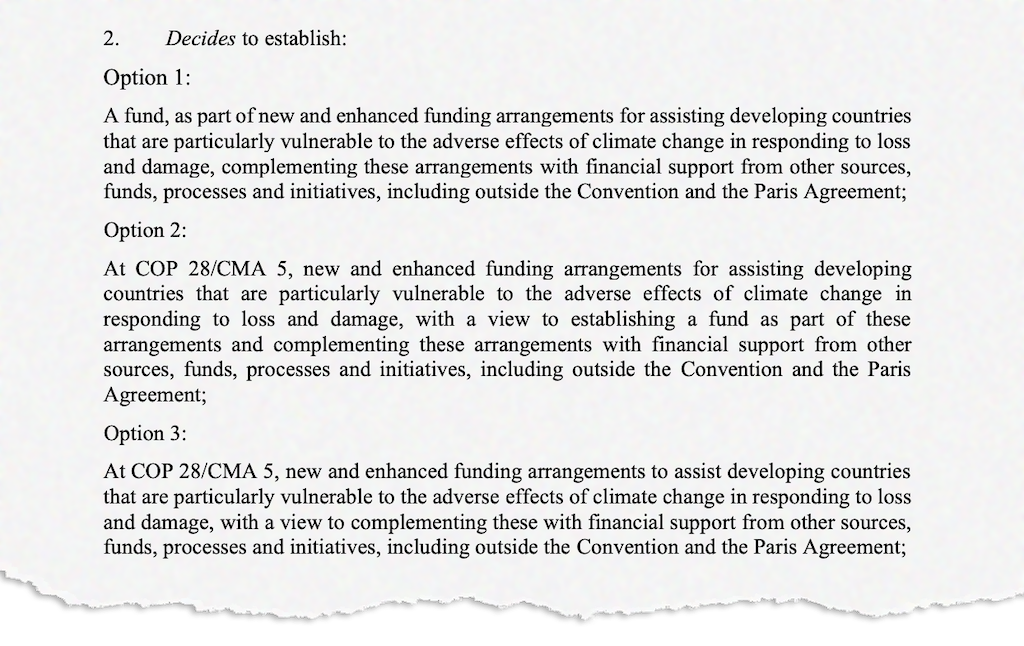
Further complication was added by a fourth option: the EU’s proposal. Speaking in a plenary session as the new text was released, Timmermans said that in the spirit of “compromise”, the EU was proposing a fund for the “most vulnerable”, supported by a “broad donor base”.
The EU’s proposal was also tied to its focus on cutting emissions in a package deal with plans to update climate plans and peak emissions by 2025. The next day, Timmermans told journalists this was the EU’s “final offer” and he would prefer not to have a new fund:
“I truly believe we could move much faster using and adapting existing instruments, but since [developing countries] are so attached to the fund, this is the proposal.”
The EU’s focus on vulnerability as a requirement to receive loss and damage finance prompted speculation around which countries would be classed as “most vulnerable”.
The Paris Agreement highlights small-island developing states and least-developed countries as examples of more vulnerable nations – a definition that NGOs pointed out would exclude disaster-struck nations, such as Pakistan and Nigeria. Timmermans later clarified that, in his view, Pakistan would be eligible for support.
Overnight, a further text proposal emerged, apparently by the US and other developed countries, sparking anger from NGO observers who condemned it as another “watered down” fund.
As the COP overran into the weekend, a breakthrough occurred. A new loss-and-damage text was released on Saturday afternoon that appeared to walk a middle ground between the demands of both the G77 and developed countries.
Crucially, it opened the fund up to all developing countries and left the door open to additional donors with a mention of the potential for a “wide variety of sources”.
#COP27 new loss and damage text
— Simon Evans (@DrSimEvans) November 19, 2022
* New fund next year
* Open to all developing countries
* Developed “urged” to support
Proposal by the president (no brackets)
https://t.co/LeW7GKA3fj pic.twitter.com/4rtS98b8wK
G77 members immediately announced their support. Alpha Kaloga, lead negotiator for the African Group, told Carbon Brief that, while it was “not an ideal text”, he was confident that a landing ground had been reached:
“It is a very exciting moment…30 years of attempts to get recognition [of] loss and damage…this has all now been solved.”
With the developed country support also anticipated, barring any last-minute concessions the fund was expected to pass.
A new text emerged on Saturday evening narrowing the pool of recipients to those “that are particularly vulnerable”, as opposed to “most vulnerable” in the earlier EU proposal.
However, following some last-minute back-and-forth between parties this was ultimately approved. Developed countries, development banks, NGOs and businesses are “urged” to support the fund, and on top of the new facility there is a reference to sources of money “under and outside” the UN process.

In his closing remarks, US climate envoy Kerry welcomed this “mosaic” of responses.
But some confusion remained around the definition of vulnerability. The text contains two references to helping developing countries that are “particularly vulnerable” to climate change. A reference to “especially” helping them was removed at the very last minute (reportedly, because it was an error introduced when drafting the text).
Observers told Carbon Brief that developing countries are happy that this text does not exclude anyone, as it mirrors the language of the original UNFCCC convention.
However, climate finance expert Liane Schalatek from Heinrich-Böll-Stiftung said she had concerns that the language might cause problems in the future, especially given the new facility is likely to be underfunded – just as other climate finance funds are. The details of accessibility and other issues will be negotiated over the coming years.
Nevertheless, developing countries and NGOs welcomed the outcome as a great victory.
Harjeet Singh, a veteran loss-and-damage expert with Climate Action Network said it “sent a warning shot to polluters that they can no longer go scot-free with their climate destruction”.
Additional loss-and-damage funding
With or without a fund, as negotiations got underway, the conference quickly became the first-ever COP to see significant sums of money being committed to loss-and-damage.
Small-island leaders, notably Barbados prime minister Mia Mottley, used speeches at the COP to demand financial help, and some wealthy countries obliged.
Powerful words from @miaamormottley calling for financial system reform and loss & damage finance.
— Josh Gabbatiss (@Josh_Gabbatiss) November 7, 2022
“We were the ones whose blood, sweat and tears financed the industrial revolution” and it’s “fundamentally unfair” to pay the cost of emissions as well, she says.#COP27 pic.twitter.com/Oi8lw1KG51
A wave of funding pledges described as addressing “loss and damage” were announced over the two weeks by nations including Austria, New Zealand and Belgium. This marked a gear shift in attitudes to funding loss and damage, which for years had been a “taboo” in climate finance.
These commitments, which amounted to more than $300m, were, nevertheless, small compared to the estimated needs of developing countries.
Moreover, when details of the funds emerged, Carbon Brief analysis showed that most of the money would not immediately benefit the victims of climate disasters. Some consisted of previously announced climate funds relabelled as “loss and damage”.
The majority was for insurance programmes, early-warning systems for extreme weather and supporting the operation of the technical body known as the Santiago Network. (See Santiago Network section below.)
NEW: There’s been a flurry of “loss and damage” pledges from rich nations at #COP27 – totalling $300m+.
— Josh Gabbatiss (@Josh_Gabbatiss) November 15, 2022
This $ is going towards a mix of initiatives, only some of which directly support climate victims.
By far the most funded is the insurance-based German/V20 “Global Shield”. pic.twitter.com/3oIG15Kg1z
By far the biggest chunk of money was for a joint initiative, dubbed the “global shield”, from Germany and the G7 with the V20 group of climate-vulnerable nations. Its aim is to provide climate risk insurance and social protection schemes in developing countries.
Ghana finance minister and V20 chair Ken Ofori-Atta welcomed the project as “long overdue”. However, insurance has a long history of being pushed in the UN process as an alternative to loss-and-damage funding.
Campaigners were, therefore, cautious, warning that the global shield should not replace other funds, as insurance schemes can burden vulnerable people and cannot protect against all climate threats. In a speech at the conference, COP26 president Alok Sharma referred to the threat of “entire economic sectors becoming unsustainable and uninsurable”.
Martin Kipping, head of climate at the German ministry of economic cooperation and development, told Carbon Brief that the global shield is, in fact, “not about insurance – it’s about protection”. He clarified that it would build on previous insurance efforts and include a variety of financial instruments, depending on where it is deployed.
Alongside other financial mechanisms, such as the reform of development banks and debt relief, the global shield was framed as part of the “mosaic” of funding solutions to loss and damage.
Another idea, advanced by Mottley and other small-island leaders, as well as UN secretary-general Guterres, was a windfall tax on oil-and-gas company profits to fund loss and damage.
Analysis of data for the first nine months of 2022 suggests that this could already have raised $24bn, due to the surge in fossil-fuel prices resulting from Russia’s invasion of Ukraine.
Barbados PM @miaamormottley has called for a 10% windfall tax on oil companies to fund #LossAndDamage caused by climate change
— Josh Gabbatiss (@Josh_Gabbatiss) November 10, 2022
Such a tax would already have raised $24bn if implemented in 2022, rising to ~$31bn by the end of the year
Profits would still be far higher than 2021. pic.twitter.com/WPgA3PDcjY
Mottley told Carbon Brief that, outside of the COP, entities with responsibility for causing climate change, “predominantly oil-and-gas companies and banks and insurance companies”, should play a role in funding loss and damage. She said:
“Beyond governments, we believe that the issue is that there are a number of non-state actors who literally are causing the problems, are benefiting from it, and we have a very simple principle…those who cause the problem should help pay for the problem.”
All of these funds were framed as part of the “mosaic” of solutions that many parties, both developed and developing, said would be required to sufficiently fund loss and damage.
Santiago Network
As the new fund drew most of the attention at COP27, more long-running matters related to loss and damage continued to bubble under the surface.
The Warsaw International Mechanism for Loss and Damage associated with Climate Change Impacts (WIM) was established at COP19 in 2013. One of its functions was meant to be “enhancing” finance – and its failure to do so had fed into demands for a new fund.
The Santiago Network, established under the WIM at COP25 in 2019, was another attempt to raise the status of loss and damage. It aims to connect developing countries with technical support, such as NGOs and development banks, to help them deal with loss and damage.
Since 2019, however, it has largely languished as a mere website set up by the UNFCCC, although last year in Glasgow some initial money was pledged to get it off the ground.
COP27 saw the network finally set up properly, with an agreement to create a real-world advisory board, including representatives from a cross-section of geographical regions, as well as organisations representing women, Indigenous people and youth.
We first drafted the #SantiagoNetwork into existence in 2019 in Madrid so this is a major moment in getting technical assistance for #lossanddamage on the ground in developing countries. The overwhelming feeling amongst negotiators is relief 🥲 that it is done! #COP27 https://t.co/BMQOU1D7NL
— Dr. Siobhan McDonnell (@SiobhanADM) November 16, 2022
It also included plans for a new Santiago Network secretariat, with a host to be decided after COP27 is over.
Mitigation work programme
COP27 finalised the details of a “work programme” to “urgently scale up mitigation ambition and implementation in this critical decade”. The summit agreed it should run until 2026, with a view to extending it further, with outcomes linked to annual decisions at each COP.
However, it was given a loose scope and told not to set targets. The work programme was a key part of the Glasgow Climate Pact’s efforts to “keep 1.5C alive”. But COP27 did not allow the programme to check progress against the promises made in Glasgow.
“Ambition” refers to the promises countries make to cut emissions. “Implementation” means turning promises into results. On both counts, countries are falling far short of what is needed to stay below 1.5C – yet a new round of Paris pledges was not due until 2025.
The Glasgow pact, therefore, asked all countries to “revisit and strengthen” their pledges by the end of 2022, with the mitigation work programme to enable bolder promises and action.
(As of 18 November, only 30 countries, responsible for a fifth of global emissions, had responded to this request with updated pledges, according to Climate Action Tracker.)
At the first “high-level ministerial roundtable” on pre-2030 mitigation, also established by the Glasgow pact, parties shared their views on how best to respond. (One observer described the event as “disappointing”, with parties “mostly re-stat[ing]…old positions”.)
The first high-level ministerial roundtable on pre-2030 ambition took place at #COP27 yesterday, with a collective call to urgently ramp up climate action and support in this critical decade.
— UN Climate Change (@UNFCCC) November 15, 2022
The Like-Minded Group of Developing Countries (LMDC), including India, Iran and Bolivia, stressed developed countries’ cumulative historical responsibility for current warming. It said these countries were now attempting to shift the burden of cutting emissions onto others.
At a plenary meeting on 17 November, LMDC spokesperson and chief negotiator for Bolivia Diego Pacheco said this was rewriting the principle of “common but differentiated responsibilities” (CBDR), which is embedded in the UN climate regime, to “common but shared responsibility”.
In an interview with Indian publication the Wire, Pacheco said his bloc could not accept this:
“Our position on this is that the [LMDC] cannot agree to rewrite the Paris Agreement and start a new discussion on procedures for pressuring developing countries to enhance mitigation action, outside the Paris Agreement.”
(The NGO-led ECO newsletter noted that the programme did go beyond the requirements of the Paris Agreement, but was needed because the Paris “ratchet” mechanism was failing to deliver.)
Similarly, Bhupender Yadav, chief negotiator for India, said developed countries “have used up a disproportionate share of the global carbon budget”. He noted they had failed to meet their collective 2020 emissions targets, calling this an “unjust transfer of mitigation burden”.
Who is responsible for climate change?
— Simon Evans (@DrSimEvans) November 10, 2022
23 developed nations in “Annex II” of the UN climate convention – inc 🇺🇸🇬🇧🇩🇪🇫🇷🇮🇹🇯🇵🇨🇦🇦🇺 – make up 12% of global population…
…yet they’re responsible for *more than half* of historical CO2 from fossil fuel#COP27 https://t.co/20xX6yxhiI pic.twitter.com/pDgHBM8rb3
The principle of CBDR says developed countries have the responsibility and capability to take the lead. Yet it will be impossible to stay below 1.5C unless all countries rapidly limit their emissions.
At the ministerial roundtable, others stressed the urgent need to go further and faster in cutting emissions to stay below 1.5C. The Association of Small Island States (AOSIS) said the mitigation work programme should aim for immediate peaking in emissions and halving by 2030, in line with the latest Intergovernmental Panel on Climate Change (IPCC) findings.
“We must push the major emitting nations, whose 2030 NDC emissions reductions are not aligned with the 1.5°C goal, to review and strengthen these targets”, stated @hon_afriyie at the @COP27P High-Level Ministerial Roundtable on Pre-2030 #Ambition. https://t.co/2wrVGht8Sp
— Climate Vulnerable Forum (@TheCVF) November 14, 2022
These competing outlooks meant parties had been unable to agree a way forward when they discussed the work programme at intersessional negotiations in Bonn in June 2022.
Specifically, negotiators disagreed over the principles, scope and timeline of work, as well as whether and how it would link to formal COP processes, to give it political impact.
Disagreements centred on who should be called on to act, whether to set recommendations or goals for specific sectors and whether it should continue for one year or until 2030.
In Bonn, Switzerland and other developed countries pushed for language calling on “major emitters with capabilities” to deliver “concrete actions” as part of the work programme.
This was a clear departure from the developed versus developing split in the UN climate regime. As such, the use of “major emitters” was strongly opposed by the LMDCs and the Arab Group.
At COP27, an initial draft dropped the “major emitters” label, but remained hotly contested. In just nine pages, it had 310 sections of text in square brackets, meaning they were not agreed.
#COP27 draft text
— Simon Evans (@DrSimEvans) November 11, 2022
This is a v important one, on the “mitigation work programme” (aka how to cut emissions faster)
The draft has 310 square brackets indicating areas of disagreement, over just 9 pages, & 28 text “options”
Every para is bracketed…
🧵https://t.co/SXuCEvL8YJ pic.twitter.com/EbTaHpcnMK
At 34 per page, this is the most bracketed text Carbon Brief has ever tracked. Wael Aboulmagd, special representative for the COP27 presidency, said the talks were “complex”.
Another early draft text at COP27 included a lengthy compilation of 52 items that the work programme should cover, according to different parties and negotiating blocs.
This list included “2030 emissions gaps for specific sectors” or “definition of sectoral standards and benchmark”. It also listed “fair and equitable distribution of the remaining carbon budget”, “carbon colonialism”, “nature-based solutions”, “circular economy” and many other ideas.
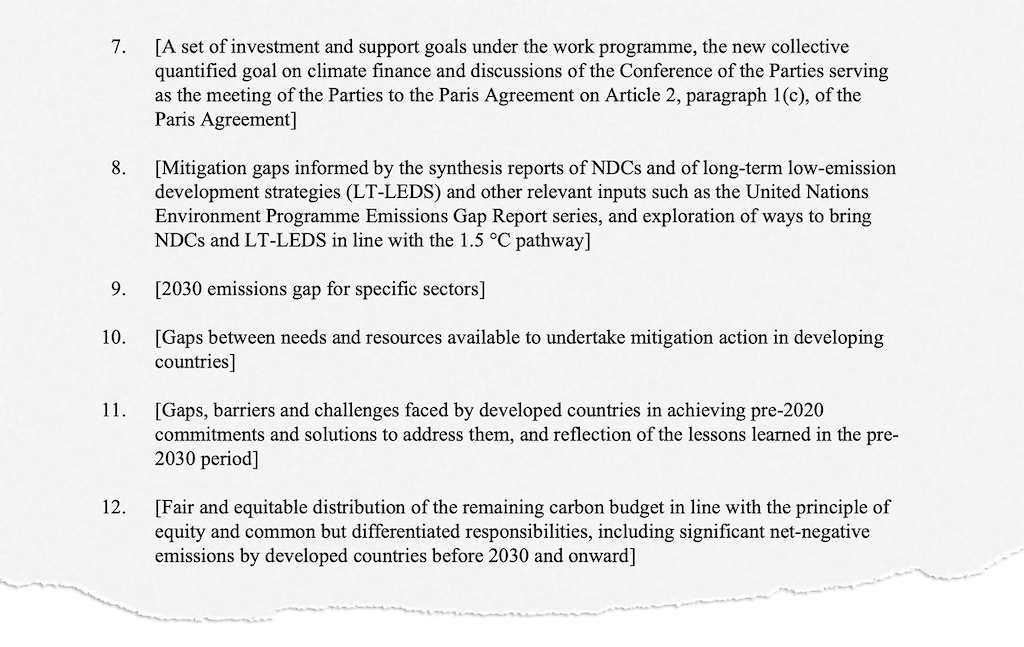
This draft also said the programme should look at detailed “sectors and subsectors”, based on the 2022 sixth assessment report (AR6) from Working Group III of the IPCC.
This specificity was significantly pared back in later iterations of the draft text. The 52-item list was removed in the second week, as was the reference to the IPCC’s AR6.
New draft text said the focus should instead be on “broad thematic areas relevant to urgently scaling up mitigation ambition and implementation in this critical decade”.
It went on to name “all sectors covered in the 2006 IPCC guidelines”. These guidelines cover just four sectors: energy; industrial processes; agriculture, forestry and land use; and waste.
The sectors are extremely broad: energy includes electricity generation, buildings and transport.
Bracketed text also gave the option of considering paragraphs 20-39 of the Glasgow Climate Pact. This would have amounted to marking parties’ homework on their Glasgow pledges.
These paragraphs include the request to “revisit and strengthen” national climate pledges, as well as the call to phase down unabated coal power and an invitation to tackle methane.
#COP27 mitigation work programme text
— Simon Evans (@DrSimEvans) November 18, 2022
Key points
Scope: to include Glasgow Pact pledges (or not)
Timeline: to 2024+review; or to 2030
Political link: draft COP decision (or not); annually or in 2024, 2026 & 2029https://t.co/HHGVgQreWb pic.twitter.com/2zMWFyWViZ
The next iteration of the text was released by the presidency at lunchtime on Saturday 19 November. It erased the link to the Glasgow pact, removing what could have been a formal way of checking progress against the promises made at COP26.
At the same time, it reintroduced a link to the “thematic areas” in WGIII of the IPCC’s AR6. This identified ways to cut emissions in buildings, transport and so on.
Moreover, the text gives leeway to include “relevant enabling conditions, technologies, just transitions and cross-cutting issues” in the scope of work.
This version of the text said the programme would continue until 2030, with a review in 2026. It also said the programme would be linked to COP decisions in 2024, 2026 and 2029.
This link to the formal, legal outcomes of COPs is the key to giving the process teeth, according to the High Ambition Coalition, which is made up of the UK, EU, small island states and others.
They had wanted the programme to result in annual COP decisions with “concrete targets and actions to reduce emissions in line with 1.5C”. Others opposed any link to COP decisions, seeing this as “telling parties how to enhance ambition”.
The agreed text, released on the evening of Saturday 19 November, shortens the timeline for the work programme to 2026. It hints that the process would be extended at that year’s COP31 (“with a view to adopting a decision on the continuation of the work programme at that session”).
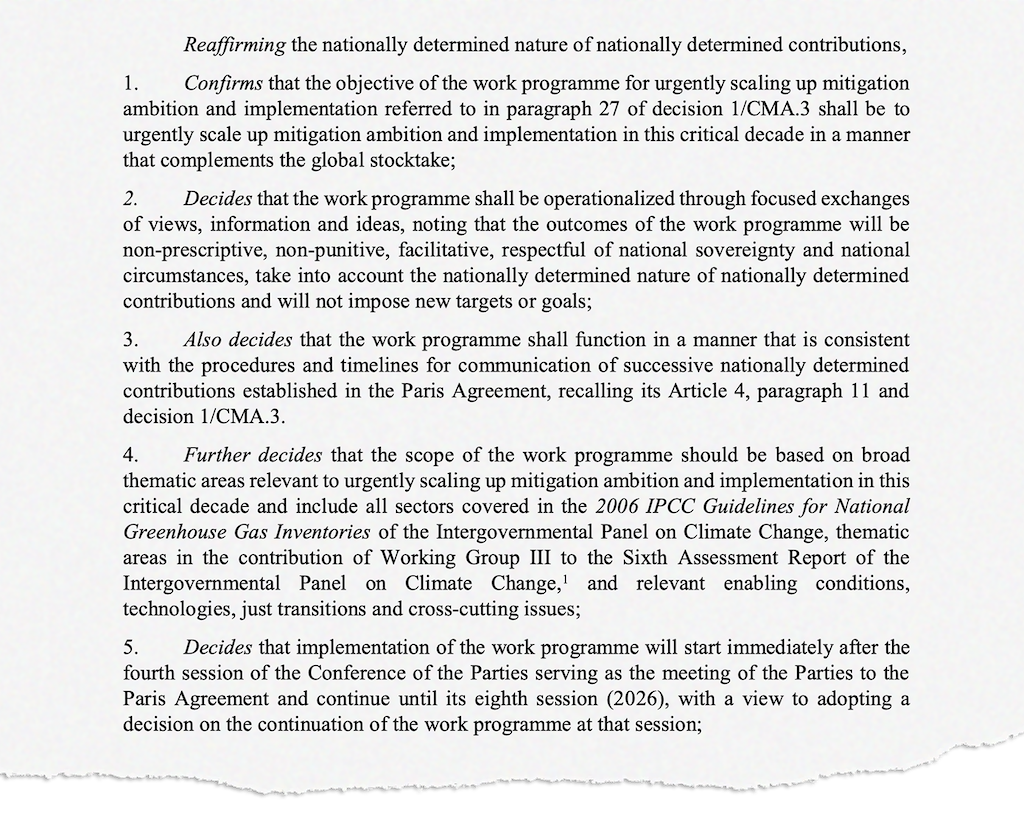
However, in what appears to have been a straight swap, the agreed text links the process to annual COP decisions. In addition, it will feed into the annual “high-level ministerial roundtable” on strengthening climate targets – and putting them into action – before 2030.
COP27 also decided that the work programme would host “investment-focused events…with a view to unlocking finance” to drive faster action. It calls on the UN’s “high-level champions” to help engage the outside world in these events.
While the final text leaves out language that could have restricted a shift in emphasis towards 1.5C instead, it still rules out the process “impos[ing]” any “new targets or goals”.
The text also stresses a “non-prescriptive” and “non-punitive” approach. As such, the programme will not force anyone to do anything, due to the “nationally determined” nature of countries’ efforts.
The text does not ask for stronger pledges, merely “recall[ing]” the request made last year. Nor does it call for global emissions to peak as soon as possible and by 2025 at the latest, which the IPCC said was a necessity for staying below 1.5C.
#COP27 new text on mitigation WP
— Simon Evans (@DrSimEvans) November 19, 2022
* Recalls but does not reiterate request to “revisit & strengthen” NDCs
* Barely maintains COP26 1.5C language
* Stresses no new targets
* No link to Glasgow pledges
* Continues until 2030
* Links to political process
https://t.co/supck0edZc pic.twitter.com/z54wnPkhJq
While the agreed mitigation work programme falls well short of the ambition developed countries had been hoping for, there are still ways it could catalyse stronger targets and action.
In a blog published ahead of COP27, Kaveh Guilanpour, vice president of the Center for Climate and Energy Solutions (C2ES), said the UN climate process had to “pivot to implementation”.
This is hard because “adversarial negotiation” is not conducive to implementation, he wrote. Guilanpour wrote in a longer report that, to be successful, the programme should focus on dialogue between policymakers rather than negotiation or politics. He wrote:
“There is a need for a deep discussion of how the COP process should evolve to deal with new realities and the shift to implementation.”
Adaptation
Once billed to take centre stage at COP27, climate change adaptation ended up languishing as somewhat of a “cinderella topic” amid widespread interest in loss and damage and plans for cutting emissions.
This is despite a large existing shortfall in adaptation funds – particularly for developing countries, with the gap widening year on year.
Ahead of the summit, new analysis from the UN Environment Programme (UNEP) warned that the amount of adaptation finance flowing to developing countries is currently five to 10 times lower than what is needed.
Estimated annual adaptation costs are expected to reach $160-340bn by 2030 and $315-565bn by 2050, according to the report. (Developed countries have still not delivered on the promise of providing $100bn annually to finance both mitigation and adaptation.)
NEW: @UNEP adaptation gap report finds:
— Daisy Dunne (@daisydunnesci) November 3, 2022
🌍Climate finance for adaptation in developing world 5-10 times lower than what’s currently needed
🌍Gap is widening year by year
Full report here: https://t.co/WFwAa7YaYZ
At the summit, developing countries “expressed strong concerns over the unfulfilled pledges of developed countries” to the Adaptation Fund, which aims to finance projects and programmes to help vulnerable communities in developing countries adapt to climate impacts, according to the Third World Network.
The Third World Network reported that South Africa, speaking on behalf of the Africa group, called out countries that have not yet fulfilled pledges to the fund made at COP26 in Glasgow. (COP26 was a record year for pledges to the Adaptation Fund, with parties such as the EU, Germany, the US and the UK promising the largest sums.)
According to the Third World Network, South Africa “stressed that developed countries ‘used and abused’ the UNFCCC platform to make pledges in Glasgow and ‘lied to the global public’ and ‘365 days later they come and give excuses about budgetary cycle’ to justify why their pledges were not fulfilled”.
The US came under particular scrutiny for its role in offering finance to the Adaptation Fund, the Third World Network reported separately. Notably, a “spat” broke out after South Africa questioned the US’s participation in informal negotiations for the fund, given that it is under the Kyoto Protocol – something the US is not party to.
The summit also saw countries continue work on the “global goal on adaptation”, a two-year work programme first started at COP26 in Glasgow.
The concept of a global goal for adaptation was first laid out in Article 7 of the Paris Agreement (see below). The idea of the work programme is to help parties figure out how the goal could work in practice, including what kind of methodologies, indicators, data and metrics could be used to track progress towards achieving it.

Several observers told Carbon Brief that negotiations for the goal were fraught, with one expert suggesting that some parties may have been acting in “bad faith” to stall progress.
On 18 November, Climate Home News reported that, according to sources, the African Group of Negotiators “repeatedly stalled discussions on a global goal on adaptation”. CHN added:
“This included a 45-minute discussion on whether to work from a PDF or Word document.”
However, responding on Twitter, Mariam Allam, lead AGN negotiator on the issue, strongly denied the allegation – adding that her group’s “willingness” to “deliver a textual proposal” for the goal was “unmatched” by other parties.
In the end, countries agreed to develop a framework for delivering the goal and tracking progress towards it. The final document takes note of the Intergovernmental Panel on Climate Change (IPCC) 2022 report on climate impacts and adaptation.
Speaking to Carbon Brief in the final hours of the summit on Saturday night, Prof Maarten van Aalst, director of the Red Cross Climate Centre and chair in climate and disaster resilience at the University of Twente, described the framework as being “in good shape”. He added:
“For those people that came from the mitigation world and wanted a simple target – like a temperature target – for adaptation, it was never going to happen. I do think the framework text that we have now has many of the right elements, it has many of the right linkages to the IPCC science, which is a really good starting point.”
Prof Richard Klein, a senior research fellow at the Stockholm Environment Institute (SEI) and professor of geography, climate policy and development at Linköping University, agreed that recognising the latest IPCC science was key. He told Carbon Brief:
“This includes the finding that climate impacts and risks are becoming more complex and difficult to manage. Compound, cascading and cross-border climate risk show that adaptation is truly a global challenge, and that countries have a shared responsibility to build systemic resilience.”
However, a call from the Africa Group to ask for an IPCC special report on the global goal on adaptation (as reported by the Third World Network) did not get backing from other parties.
Adaptation also featured in the final agreement from COP27, the “Sharm el-Sheikh implementation plan”.
A key pledge for developed nations to double their adaptation finance from 2019 levels by 2025 – considered a major win for developing countries when included for the first time in the Glasgow climate pact in 2021 – was subject to a shift in language from the draft to the final version of the implementation plan.
The earlier version of the cover text mentioned the need to develop a roadmap for doubling adaptation. The latest version has removed it. Instead, it requests Standing Committee on Finance to prepare a report on the doubling of adaptation finance
— Down To Earth (@down2earthindia) November 19, 2022
According to Down to Earth in India, a draft version called for a roadmap on doubling adaptation funds. However, the final version of the text removes this and instead requests the Standing Committee on Finance prepare a report on the matter.

It comes after a request for a specific COP27 agenda item on doubling adaptation finance from the Africa Group was denied.
Finance
Loss-and-damage finance was the big-ticket item, but traditional climate finance for cutting emissions and helping people adapt to climate change was also a major issue at COP27.
Calls for reforming financial systems and more private involvement to scale up low-carbon investments also seeped into the halls of Sharm el-Sheikh.
At the top of many people’s minds was the missed $100bn target. The EU, the US, Japan and other wealthy nations pledged over a decade ago to raise this sum annually by 2020, to fund climate projects in the developing world. Having failed to do so, they now face the task of raising their contributions and rebuilding trust in the process.
Perhaps the most important climate finance negotiating track at COP27 was the one devising the new goal that will take effect beyond 2025, replacing the $100bn target.
Considering the $100bn was, as Canadian climate minister Steven Guilbeault told one event, “basically pulled out of a hat”, a vital part of this stream will ultimately be coming up with a new number, based on a full assessment of developing countries’ needs.
At the first “technical expert dialogue” concerning this new target held in March, South African negotiator and Standing Committee on Finance (SCF) co-chair Zaheer Fakir suggested a goal in the range of $1-2tn each year.
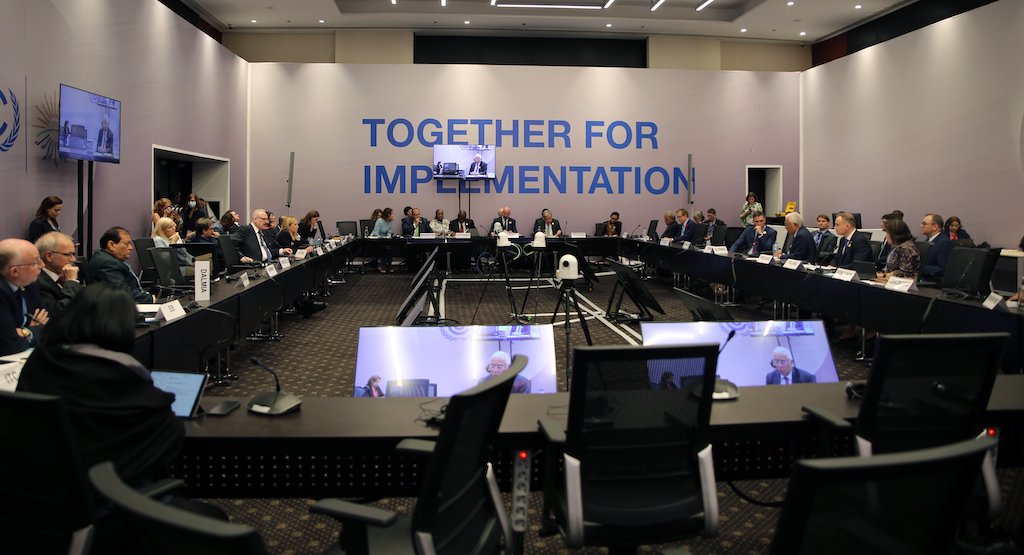
Separately, a report by a UN high-level expert group on climate finance released during COP27 found developing countries would need to spend $2.4tn per year on climate-related issues by 2030, with around half provided domestically.
These figures reflect the widely understood need to scale up the climate finance flowing to developing countries from “billions to trillions”.
The COP27 cover text contains several references to the gaps between current flows and developing nations’ needs. This includes the SCF’s estimate that such flows in 2019-2020 were roughly one-third of what is required to achieve the Paris Agreement’s 1.5C target.
However, nothing in UN climate talks happens fast, and the COP27 negotiations were never meant to result in a new finance target this year. First, negotiators are undertaking a total of 12 technical expert dialogues by the end of 2024, one of which took place in Sharm el-Sheikh,
In that time they will discuss not just the scale of the new target, but also the sources. Developed nations reportedly tried, unsuccessfully, to introduce text about expanding the list of climate-finance contributors to include non-island “high-income” countries, which would draw in South Korea, Saudi Arabia and Israel, but not China.
These discussions also focus on the quality of climate finance. For example, developed countries already struggling with debt do not want climate finance to be provided as loans, as much of it currently is. As it stands, the definition of “climate finance” within the UN system is unclear, meaning donor countries interpret it as they like.
Climate finance is a big issue at #COP27 , but there’s no fixed definition of what “climate finance” is.
— Josh Gabbatiss (@Josh_Gabbatiss) November 11, 2022
This leads to much frustration, yet many parties want to keep it that way.
☑️Definition: 🇮🇳🇰🇪🇻🇺 African Group, AILAC, AOSIS, LDCs, LMDCs
❌No definition: 🇺🇸🇨🇦🇪🇺🇯🇵🇳🇴🇮🇩🇵🇭
Driving progress on all of these issues in the post-2025 discussions is a “daunting” task, international climate finance advocate at the National Resources Defense Council (NRDC) Joe Thwaites explained to Carbon Brief.
“There’s all these different pieces and they’re all dependent on each other”, he said, making it difficult to advance one section while leaving others behind.
Even so, there was hope from developing countries in the G77 that some of the technical discussions around the post-2025 goals could be reflected in the final text. Other parties opposed this, on the basis that it was too early in the process.
In the end, the text from these negotiations did not contain any major outcomes, leaving a lot more work to do further down the line.
New draft text on the new climate finance goal (the one replacing the $100bn target beyond 2025).
— Josh Gabbatiss (@Josh_Gabbatiss) November 18, 2022
There are still 8 technical expert dialogues to get through over the next 2 years
This text remains fairly procedural, with not much in the way of concrete steps to set a new goal. pic.twitter.com/a9ro8RQFPU
Another negotiation track, known as “long-term climate finance”, concerned the delivery of the £100bn. The matter is still relevant as the target is meant to be hit every year until 2025.
“Meeting the $100bn remains critical in terms of political momentum,” Eddy Pérez, international climate diplomacy manager at Climate Action Network Canada told Carbon Brief. Otherwise, he said, “it would be too easy for developed countries to shift the focus away from their obligations”.
Comments in a week-one side event by John Kerry, climate envoy for climate-finance laggard the US, suggested this concern was justified.
Climate envoy from the world’s biggest historical emitter John Kerry, on the missing climate money from rich countries:
— Josh Gabbatiss (@Josh_Gabbatiss) November 8, 2022
“Everyone is upset that the $100bn has not been fulfilled.”
“Its at $90-something…when I got 90-something on a test at school I felt pretty good.”#COP27 pic.twitter.com/efZ42qrvK7
Leaders from wealthy nations emphasised the role that private finance would have to play in increasing climate finance.
Kerry himself proposed a controversial plan that involved selling carbon credits to businesses to raise money for the broader energy transition. This came just days after a UN high-level expert group released a report criticising “undue reliance on the use of offsets” for net-zero goals.
The final COP27 long-term climate finance text notes “challenges in mobilising finance from private sources”. Indeed, the amount of private finance mobilised has remained roughly the same for the past decade. As Dr Rishikesh Ram Bhandary, a climate-finance expert at Boston University Global Development Policy Center, told Carbon Brief:
“We’re hinging so much of this on private finance mobilisation…have we learned enough about the conditions that require private finance to be mobilised at scale?”
Furthermore, as Least Developed Countries (LDC) chair and Senegal’s climate lead Madeleine Diouf Sarr told Carbon Brief, nations like hers cannot rely on the private sector to provide all of their needs.
“As LDCs we are looking for grants, and grants are not coming from private finance.”
A progress report released by the governments of Germany and Canada ahead of the COP laid out some key priority areas for achieving the $100bn goal. It included plans for a study of “lessons learned” on mobilising private finance, with the intention of influencing the creation of the new goal.
Just energy transition partnerships (JETPs), first launched at COP26 as a new way to help fossil fuel-dependent nations shift towards clean energy in a fair and equitable way, were another measure being trumpeted by wealthy nations. A $20bn JETP for Indonesia was described by a US treasury official as the largest climate finance transaction ever.
One year after their creation, JETPs also found their way into the COP27 cover decision as an example of a “cooperative approach” for cutting emissions.
However, with details of the first JETP for South Africa showing that much of the money committed so far has been loans. Alia Kajee, a South African public finance campaigner with 350Africa, told Carbon Brief this has “not met our expectations for financing for a just transition, as the social justice outcomes such as worker or community protection would largely come out of grant-based financing.”
The COP also came amid pressure from all sides to reform the international financial system, including the World Bank and other multilateral development banks (MDBs), to make them channel more money into climate projects. COP26 president Alok Sharma told an event that the world needed a “Bretton Woods 2” moment.
The cover text (below) calls on the nations who act as shareholders of these institutions to undertake a series of reforms “with a view to substantially increasing climate finance”.
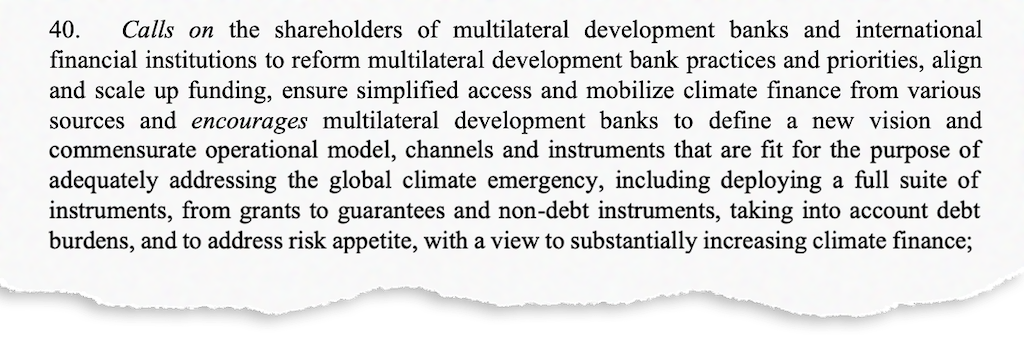
During the event, French president Emmanual Macron came out in support of Barbados’ prime minister Mia Mottley and elements of her “Bridgetown agenda” – a suite of proposals seeking to restructure global finance flows.
A final, related, issue that never made it onto the agenda at COP27 is Article 2.1c of the Paris Agreement, which refers to “making finance flows consistent with a pathway towards low greenhouse gas emissions and climate-resilient development”.
This idea is fairly open-ended, but could draw in some of the issues already being discussed such as reforming MDBs and boosting private finance. It was backed by the UK and the EU.
EU negotiator Jacob Werksman mentioned this topic when he told Carbon Brief that rather than focus on specific funds for mitigation, adaptation and loss and damage finance, which have a tendency to “get blurred” together:
“What you really want to be doing is making investments that achieve all of those goals, and so the challenge is making sure that the overall pie is growing rather than the relationship between the different slices of the pie.”
However, the issue faced pushback from many other parties. Bhandary explained:
“The underlying worry perhaps is that if 2.1c becomes the focus then maybe public finance loses the attention that many countries would like it to have.”
Ultimately, the final cover text launched a “Sharm el-Sheikh dialogue” on this matter, which will report back at COP28.
Koronivia joint work on agriculture
Against a backdrop of rising food prices, war impacting key commodities, extreme weather affecting yields of key crops and record levels of hunger, agriculture and food security were expected to be a key priority for delegates at COP27.
The Koronivia Joint Work for Agriculture (KJWA), which is the formal UNFCCC workstream for handling these issues, was given another four-year lease of life at COP27, as parties agreed to continue working on “implementation of climate action on agriculture and food security”.
While the UN has a range of different bodies dedicated to different aspects of food – from the Rome-based Food and Agriculture Organisation to the Committee on World Security (CFS) – Koronivia was the only dedicated forum to bring together discussions about agriculture and climate change. With it, agriculture became the only sector to have its own negotiations track within the UNFCCC.
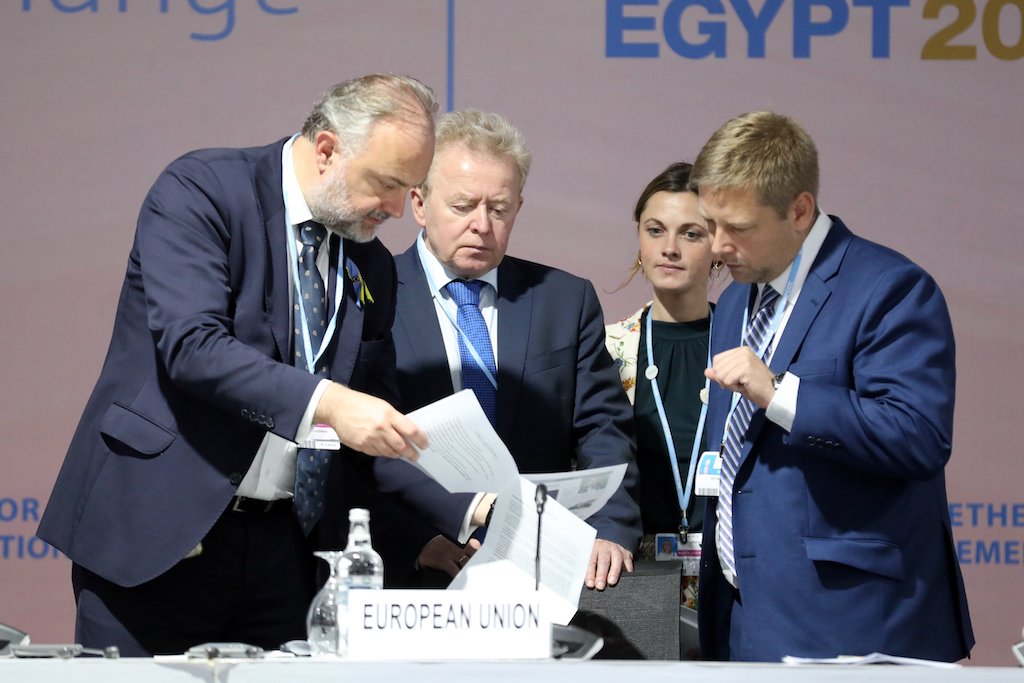
Set up via a landmark decision in 2017 at COP23 in Bonn, as a subject under both subsidiary bodies, Koronivia set out to address six interrelated topics: soils; nutrient use; water; livestock; adaptation and its co-benefits; and the socio-economic and food security dimensions of climate change across agriculture.
After a series of cross-cutting workshops on these subjects that nearly all participants said they found useful, Koronivia was scheduled to wrap up at COP26 in Glasgow.
At COP26, however, countries could not come to an agreement on what they conclusively, collectively learned from these workshops. They also could not reach consensus on what the next “roadmap” for the future of Koronivia should look like.
They did agree, though, that they would come to a decision at COP27 on whether work on food would continue – and, if yes, in what form.
In their submissions ahead of COP27, parties were divided about whether Koronivia should go on, for how long, governed by whom and in what format, namely, as a constituted body under the UNFCCC, as a work programme, or just linked to other bodies. To many observers, the format did not matter as much as an assurance that the work would continue.
Where should Koronivia go, if it goes on?
— Aruna Chandrasekhar (@aruna_sekhar) November 12, 2022
Will it be a mechanism, a work programme, a constituted body? Each has its own power, ability to call meetings, ⌛️ and 💸 implications.
Countries have different perspectives on that, too. pic.twitter.com/etSVGaKeBj
Tensions over mitigation and loss and damage made headlines towards the end of COP27. But, at the end of week one, the subsidiary body chairs said that agriculture “took more meeting time than any other item at COP27”.
Campaigners feared that agriculture was “limping on and possibly heading towards an abyss”, according to Bernadette Fischler Hooper, head of international advocacy at WWF UK, given the prospect of Koronivia being pushed by another year.
A negotiating draft for discussion on Koronivia’s future emerged late on 11 November, with only a day to go before the subsidiary bodies had to conclude their work.
While this text agreed to set up “joint work”, just how long it would run was not agreed upon. It also mentioned a possibility to broaden the scope of the work to take a “whole of food system perspective”, which became a key dividing element between countries that already have language around food systems in policies such as Farm to Fork, versus countries who were either unclear or reluctant to talk about aspects such as consumption and diets.
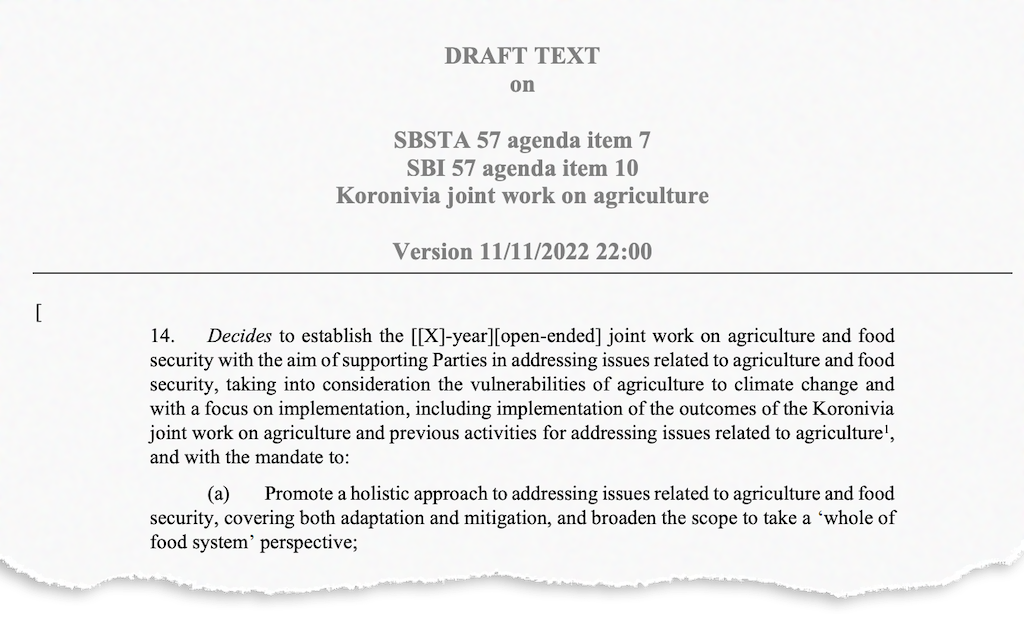
G77 plus China reportedly wanted references to broadening the scope to a “whole of food systems” approach deleted, while countries such as the UK, France and Switzerland wanted to keep food systems in. According to a report in Devex, the G77 was opposed to “food systems” language because it “needed more clarification”.
Eventually, the subsidiary bodies forwarded both texts in brackets – one on conclusions and the other on Koronivia’s future – to be picked up by the COP, with the Egyptian presidency agreeing to work on the text and pacify parties.
❌The data❌
— Jazmín Rocco Predassi (@JazPredassi) November 11, 2022
Koronivia Joint Work on Agriculture has had more than 20 hours of negotiations in the past week, more than any other agenda item. Yet… Negotiations will continue next week under #COP27
At the start of the second week of COP27, 29 organisations, including WWF, the Environmental Defense Fund, Food and Land Use Coalition and GAIN, appealed to negotiators in an open letter, asking them to retain “sustainable food systems” language “in the context of the Koronivia Joint Work on Agriculture, which means taking a particular focus on sustainable food production, nutrition and dietary shifts, as well as food loss and waste”.
Mid-way through the second week, a new combined text emerged, with a “whole of food systems” approach deleted, a tentative three-year timeline in brackets and more language on implementation, support and vulnerability.
With both docs combined, 🥁🥁 new🌾draft text: L (old), R (new). https://t.co/hk6yxtBU5A
— Aruna Chandrasekhar (@aruna_sekhar) November 15, 2022
Possibly a 3-yr joint work programme?
Missing: ‘whole of food system’ perspective.
Added/emphasised: implementation, support, adaptation priorities of vulnerable groups, nat circumstances pic.twitter.com/6vUtOo1fUN
On Thursday, Koronivia consultations concluded just shy of midnight, producing mostly agreed text, a definite four-year timeline for agriculture and food security and a new proposed Sharm-el-Sheikh online portal for countries to share information. However, with India objecting to the words “climate action” and preferring “action”, both words appear in brackets in the title.
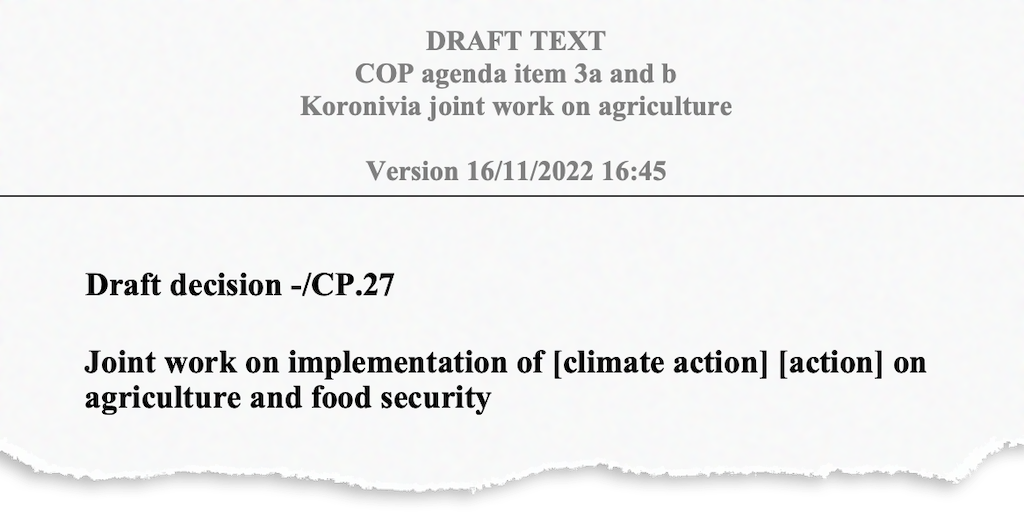
While title brackets were removed the next day, references to a first workshop on food systems were deleted, reportedly on the insistence of the US.
1/8. My quick take on #agrifood systems related outcomes from @COP27P
— Dr. Aditi Mukherji (@aditimukherji) November 20, 2022
1. The term food systems has been meticulously avoided in #Koronovia because of sensitivities around demand side measures such as diets by developed countries, and mitigation concerns by developing countries
Clean text notwithstanding, India pushed back on the Koronivia draft decision on Friday, the day COP was scheduled to close, alleging, as reported by the Hindu, that “developed countries are blocking a pro-poor and pro-farmer decision by insisting on expanding the scope for mitigation to agriculture, thereby compromising the very foundation of food security in the world”. To date, India has not made a submission on Koronivia’s future or recommendations.
Eventually, the text on Koronivia was passed at the COP on Sunday morning, shortly before the final gavel. It was the only agenda item that drew interventions from countries in the closing plenary, with Turkey asking for language around water insecurity to be amended, while Russia objected to any such changes.
Despite the fight and deletions, the conclusions on Koronivia “points us in the right direction for agriculture”, said Teresa Anderson of Action Aid. She told Carbon Brief:
“They spent five years with a series of comprehensive workshops that actually made an effort to really listen: to farmers on the ground, IPCC scientists, pastoralists…It was actually one of the more inclusive, if not the most inclusive processes in the UNFCCC. With this, we might not be galloping but we’re tiptoeing in the right direction.
“The decision is saying it is time to move away from business as usual, it is time to work more with nature and smallholder farmers. It didn’t give big agriculture the space it was hoping for, but really emphasised the input of smallholder farms, the importance of food security and equity. All of that came through.”
Article 6
Article 6 of the Paris Agreement is one of the most technical parts of the UN climate process. It concerns cooperative approaches to cutting emissions, primarily via carbon trading.
While the Article 6 “rulebook” was completed at COP26 in Glasgow, COP27 faced decisions on the machinery, definitions and procedures that are still needed before any trading can begin.
Several contentious issues were deferred, including how to treat emissions “removals”, whether to allow credits for “emissions avoidance” and when carbon credits could be “revoked”.
Other decisions made at COP27 raised eyebrows among NGOs, including loose provisions on confidentiality and the potential “double-claiming” of certain types of carbon units.
According to the Earth Negotiations Bulletin summary of COP27, the summit “managed to deliver a significant amount of guidance that will help operationalise” the system.
Yet with trading under Article 6 unlikely before 2024 at the earliest, observers told Carbon Brief the negotiations risked becoming a “sideshow” as voluntary carbon markets take off.
Tennant Reed of the Australian Industry Group said in a 10 November update from COP27:
“The negotiations are in a very boring, very technical minutiae crawl, into the next layer of detail from what was agreed in Glasgow. Even people who are much bigger enthusiasts on this stuff than me, when asked, are saying it’s a bit of a slog.”
Article 6.2
Article 6.2 defines the “internationally traded mitigation outcomes” (ITMOs) that countries can buy and sell from each other, towards their targets under the Paris Agreement.
Key decisions at COP27 included what information countries would need to report when trading ITMOs and whether this reporting could be kept confidential.
The agreed text gives countries complete control over whether to keep this information secret. It says they “may designate information…as confidential”. It asks them to explain why they are doing so, but, unlike in earlier drafts, this is the optional (“should”).
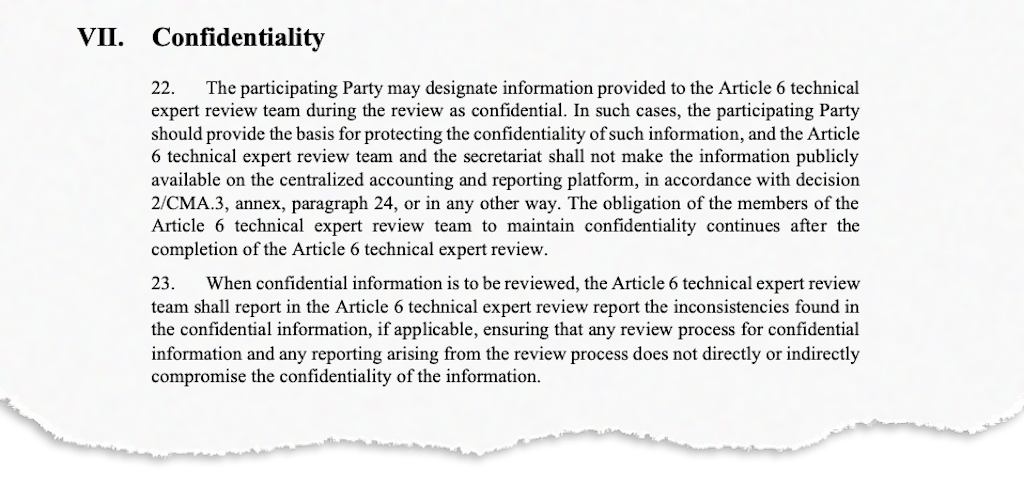
One Article 6 observer said unconstrained confidentiality around carbon trading risked “confirming our worst fears of greenwashing”. Another told Carbon Brief:
“The confidentiality provisions on [Article] 6.2 are embarrassing. You could drive a space shuttle through that loophole and have plenty of room on all sides.”
Catalina Gonda, climate policy coordinator at Fundación Ambiente y Recursos Naturales (FARN), said the COP27 guidance on the review process for Article 6.2 is “not ambitious enough in terms of transparency and accountability”. She told Carbon Brief:
“There is a high risk that the review process ends up toothless and inconsequential, leaving this cooperative approach with barely any oversight.”
The COP27 decision asks the technical body of the UN climate regime (SBSTA) to develop rules that might constrain the use of confidentiality. It asks countries to submit their views on this matter before the next intersessional meeting in Bonn in June 2023.
Other questions that will be taken up again at future meetings include how to link the infrastructure necessary to trade carbon credits via a “centralised accounting and reporting platform” (CARP).
The accounting and reporting machinery around Article 6 carbon trading is almost entirely impenetrablehttps://t.co/F2q9BNy0x6 pic.twitter.com/ChWMZRM2up
— Simon Evans (@DrSimEvans) November 21, 2022
This is another technical, but important process. A lack of comparable information could make the trade, ownership and appropriate use of carbon credits difficult to verify.
Renaud Bettin, vice president for climate action at carbon management software provider Sweep told Carbon Brief the CARP was “key here to understanding the increasing volume of credits that will be exchanged, and preventing the distrust in carbon markets”.
COP27 also deferred the question of ITMOs being revoked. Some parties would like the option to revoke carbon credits they have issued – if, for example, it later becomes clear they need those emissions reductions to meet their own targets.
However, this simple-sounding idea could have profound implications for the operation of the Article 6.2 machinery. David Burns, natural climate solutions policy lead at the World Resources Institute (WRI), told Carbon Brief via email:
“It’s caused a fair amount of confusion and parties are struggling to navigate the implications for infrastructure, tracking, reporting, etc.”
A 46-page report from the Organization for Economic Cooperation and Development and the International Energy Agency explores a range of scenarios where credits might be revoked.
Crucially, the spectre of “retrospective revocation” is spooking market participants, according to a COP27 daily update from the International Emissions Trading Association
One successful outcome from COP27 was agreeing the “initial report outline”, says Juliana Kessler, consultant at Perspectives Climate Group. This outline is “crucial” to the start of cooperation under Article 6.2, Kessler told Carbon Brief.
The outline is contained in Annex V of the COP27 text and lists the information countries need to submit about any carbon trading deals they agree with other nations.
While the full rules of procedure for Article 6.2 remain unresolved, some countries are already pushing ahead with agreements.
Switzerland has inked deals with Ghana and Dominica. It will fund projects such as transport electrification, using the carbon savings to help meet its own targets.
Article 6.4
The second part of Article 6 will create a new international carbon market. This will allow carbon-cutting projects to sell offsets, known as “Article 6.4 emissions reductions” (A6.4 ERs), for use towards national climate goals or for other regulatory purposes.
Negotiations at COP27 included the definition of carbon “removals”, meaning engineered or natural processes that suck carbon dioxide (CO2) out of the atmosphere.
A “supervisory body” set up to run this new carbon market had been tasked with suggesting rules on what should count as a carbon removal and when this could generate carbon credits for sale.
However, after delays to the start of its work, it was only able to agree these recommendations in the small hours of the night before COP27 began.
NGOs immediately declared that the recommendations could “undermine the integrity of the Paris Agreement” and lacked appropriate safeguards on human rights and other matters.
🔥🙈#COP27 barely started & recommendations are already adopted that would seriously undermine the integrity of the #ParisAgreement
— 🕊 Sébastien Duyck – at #COP27 🌍⚖️ (@duycks) November 6, 2022
Last night, the supervisory body on #carbonmarkets finalised recommendations regarding “removals”
3⃣ things to know about this outcome…
🧵[1/7]
Many parties also objected to the recommendations, with Third World Network reporting that the ABU grouping of Argentina, Brazil and Uruguay had called them “extremely problematic”.
Ultimately, COP27 sent this guidance back to the supervisory body for more work – an agreement supported by at least some of the body’s own members. It also said the recommendations should take into account “avoidance of other negative environmental and social impacts”.
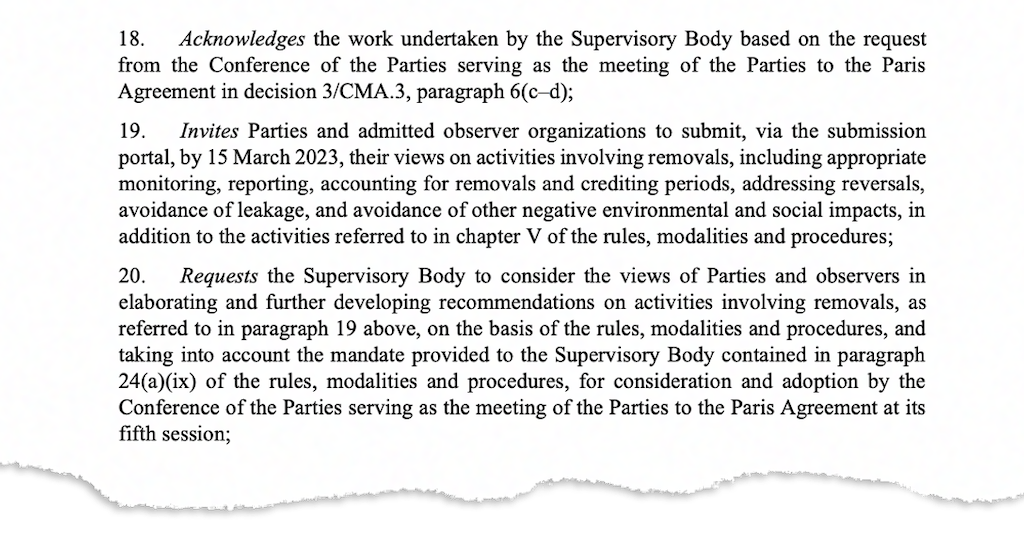
Another point of controversy concerned A6.4ERs issued without authorisation for use towards the buyers regulatory requirements. These “non-authorised” ERs had been floated at COP26, but had not been clearly defined or constrained.
At COP26, countries agreed that host nations should make “corresponding adjustments” to their emissions inventory when selling credits overseas, to prevent “double-counting” of any reductions.
Importantly, however, non-authorised ERs were implicitly left out of this requirement, leaving the door open for the host nation and buyers “double-counting” any carbon savings.
While COP27 did not completely shut this door, it named these units “mitigation contribution ERs” and gave a clear indication that they should only be used towards host country targets.

Gonda told Carbon Brief this should send a clear message to markets:
“By clearly labelling units that are not authorised by parties for transfer as ‘mitigation contributions’, these guidelines send a strong message to the voluntary market to start shifting from an offsetting paradigm to financing emissions reductions.”
Finally, the agreed text also removed earlier language saying the Article 6.4 carbon market “shall contribute to global efforts on climate change for scaling up mitigation ambition and implementation”. (In the context of UN legal decisions, the word “shall” is a firm requirement.)
The final agreement on Article 6 at #COP27 opens the door to secret carbon market deals. On a positive note, a new type of carbon credit could help spell the end of offsetting, but the agreement falls far short of what is needed.
— Carbon Market Watch (@CarbonMrktWatch) November 20, 2022
Read our press release: https://t.co/oq6qZ9V9Xc
Article 6.8
The third part, Article 6.8, covers “non-market approaches” (NMAs) to climate cooperation, for those wanting a way to get paid for their climate efforts without involving markets.
The term “NMA” is ill-defined, with one observer noting it could mean “anything and nothing”. COP26 established a “Glasgow Committee” to gather examples and consider what to do next.
A 13-page secretariat technical report, prepared ahead of COP27, looks at what NMAs already exist and how countries are using them. It gives examples, such as the Adaptation Benefit Mechanism (ABM), REDD+ and the Cleaner Energy Future Initiative for ASEAN (CEFIA).
Points of contention in Egypt included the order of priority for the work programme agreed at COP26 and whether to have a second phase of NMA implementation.
NEW #COP27 text
— Simon Evans (@DrSimEvans) November 8, 2022
Article 6.8 “non-market” cooperation
COP26 set up a work prog & to-do list
New 17pp draft text has 130 square brackets & 72 “options”, indicating areas of disagreement
Key Qs inc which to-do list items to tackle 1st & what to do nexthttps://t.co/caJ8zRCmlD pic.twitter.com/udB98zIea8
Parties also disagreed on the purpose of a UNFCCC-hosted web portal for NMAs. Some countries said this should simply showcase planned or existing work, whereas others said it should offer a “matchmaking” service to link projects with potential funders.
The agreed text asks the Glasgow committee to continue its to-do list for the next two years, followed by a “learning-by-doing” approach to putting its findings into practice.
It says the NMA web portal should be voluntary, with submissions setting out the activity planned and the support available or needed to move forward. It says parties can use the portal, if they wish, to engage in efforts to “match” projects with funders and vice versa.
Global stocktake
The global stocktake (GST) is a five-yearly temperature check that is a vital part of the Paris Agreement. When nations signed onto the agreement in 2015, they also agreed to monitor, assess and periodically review different aspects of their climate actions and take stock of collective progress towards meeting the world’s warming goals.
Housed under Article 14 of the Paris Agreement, the global stocktake is meant to help countries collectively assess where they are, where they want to go and how to get there in terms of climate action. It is an assessment of “mitigation, adaptation and the means of implementation and support, and in the light of equity and the best available science”.
But the stocktake is not just a report card on emission cuts taken so far. It is also a review of climate finance provided by developed countries, such as their failure to deliver on the $100bn promise by 2020, which, in turn, influences “ambition” and expectations of developing countries to make bolder climate pledges.
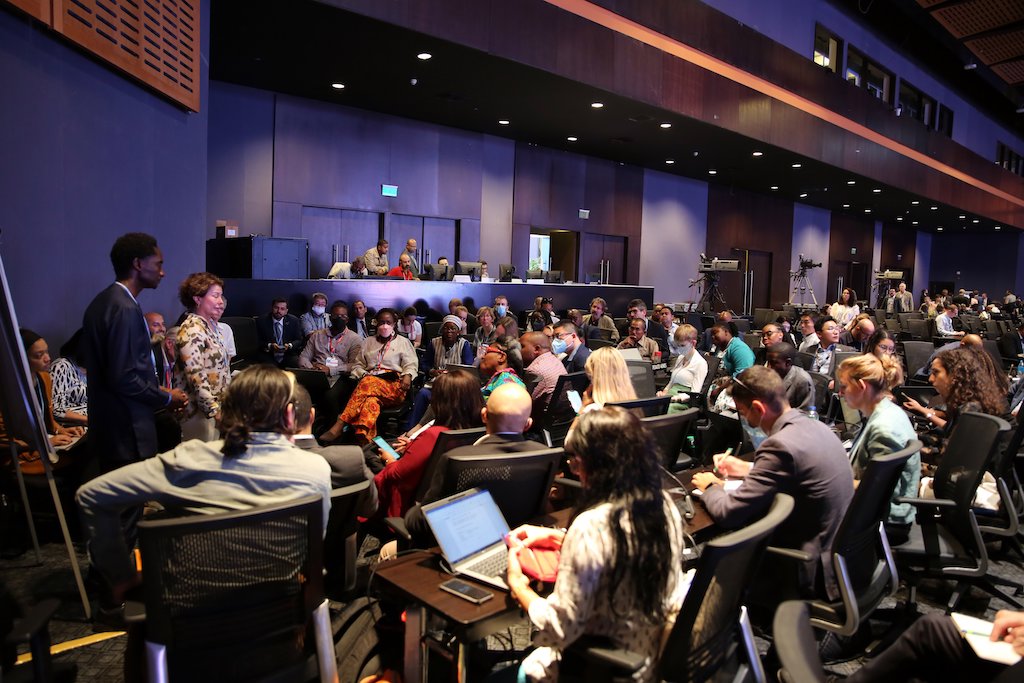
Developed countries reiterated an intention to meet this missed target by 2023, which also coincides with the start of the first global stocktake that is meant to inform countries making new, more ambitious climate plans.
The stocktake ends before the next round of submissions of countries’ climate plans in 2024-2025. In a briefing call before COP27, Prof Navroz Dubash of the Centre for Policy Research said:
“The stocktake may seem like a sleeper issue, but it is the key to the ratchet mechanism in the Paris agreement. One of the things that the stocktake could do is give legitimacy to a narrative that emerges, a new way of talking about issues. For example, language around solidarity or loss and damage, it can kind of elevate a few concepts and give them momentum.”
“Technical dialogues” are a core component of the two-year long global stocktake process that is divided into an 18-month technical phase, followed by a political phase in 2023. While COP26 provided the venue to finalise the rules for these dialogues, COP27 was the ground for the second meeting of the first technical dialogue.
Unlike fraught political negotiations, these dialogues have been framed as a “conversation” between countries, climate experts and civil society, engaged in a series of roundtable discussions on mitigation, adaptation including loss and damage, and finance, technology and capacity-building. Participants are invited to share assessments, the best-available science, but also experiences, case studies, challenges and barriers to climate action.
At COP27, observers told Carbon Brief that fossil fuel industry lobbyists were very visible and vocal at all roundtable discussions. The Lancet’s Arthur Wyns, who describes the global stocktake as a “health check for the Paris Agreement”, told Carbon Brief:
“The Technical Dialogue of the Global Stocktake – which took place during the first week of COP27 – was designed to be very inclusive and dynamic. Unfortunately, this meant that fossil fuel lobby groups were able to insert themselves into many conversations, while parties like Saudi Arabia were openly promoting false solutions to the climate crisis, like carbon capture and storage (CCS).”
Participation concerns aside, text and decisions on the global stocktake passed seamlessly without contention. The SBSTA and SBI invited submissions from parties and non-parties by 15 February 2023 on how outputs of the stocktake should be considered, followed by a consultation in April and an in-person workshop in October.
They encouraged countries “to hold events, at the local, national, regional and international level, as appropriate, in support of the global stocktake”, which invited reactions from some parties’ about the budgetary implications of the global stocktake.
The cover decision welcomed the UN secretary general’s offer to convene a “climate ambition summit” before the first global stocktake concluded ahead of COP28.
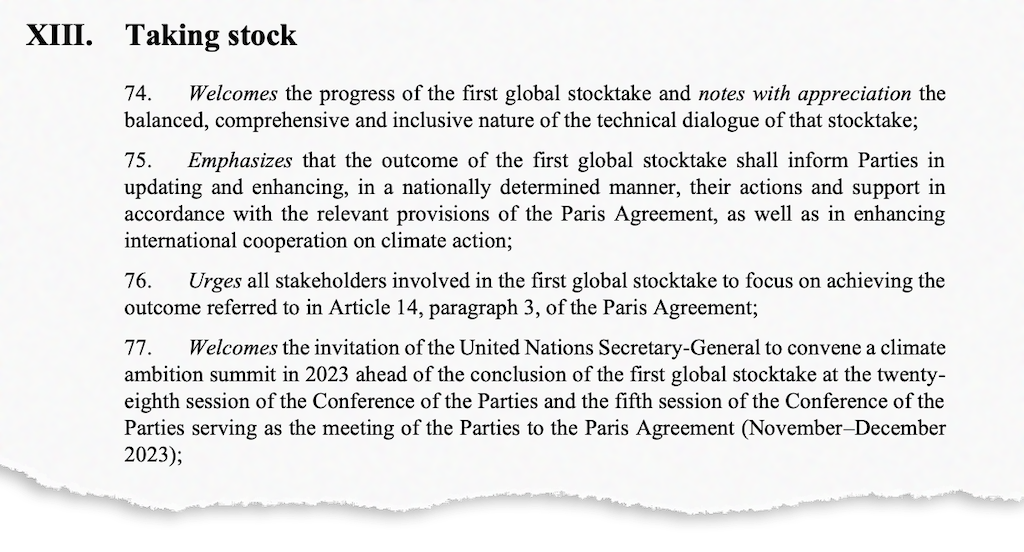
While the dialogue this year was largely non-controversial, the political process spread over 2023-2025 is “important and where the real question mark lies,” said Dr Jennifer Allan, senior lecturer in international relations at Cardiff University. She told Carbon Brief:
“[When] countries go away, take the stocktake and use it to inform new ambitious NDCs, that’s the link where we don’t know how that bridge will happen. There’s no real mechanism in the Paris Agreement, besides learnings and hopes and best wishes. The big, unanswered questions are how this will become a political outcome for the next COP in the UAE and how to ensure that informs new NDCs two years later.”
COP27, in effect, marks the transition from the GST’s information-gathering technical phase to the political phase, which will play out next year. While this political outcome in 2023 at COP28 is expected to be one of the UAE’s key deliverables, Wyns told Carbon Brief that “UAE shared little vision on how to move GST from technical to political phase in 2023”.
Response measures
The Paris Agreement target of keeping warming to “well below 2C” and ”pursuing 1.5C” requires “enhanced ambition” when it comes to reducing emissions.
Policies to deliver this will lead to impacts – both positive and negative – on economies that currently rely on the production of fossil fuels. To consider these impacts, COP17 in 2011 set up the “forum on the impact of the implementation of response measures”.
The most recent “response measures” work programme at COPs covers the following issues: economic modelling and socio-economic assessments; discussion of opportunities for economic diversification; just transition of the workforce; and the creation of decent work and quality jobs.
Crucially, neither the work programme, nor its “Katowice Committee of Experts” (KCI) forum, are concerned with the administration of finance.
The response-measures forum has tended to serve as a staging ground for proxy battles fought elsewhere at the conference. As a result, it is rare for the negotiations to reach a conclusion during the early stages of COP negotiations.
In Sharm el-Sheikh, negotiations under SBSTA and SBI stretched until the middle Saturday, beyond the last day of scheduled technical negotiations. They continued under COP, CMA and CMP during the second week until late on the evening of the second Thursday.
Enduring disagreements revolved around the midterm review of the forum and its KCI six-year workplan – and which additional activities should be added to it.
Disagreement also surrounded references to “activity related to assessing the positive and negative impacts of the phasedown of unabated coal” – wording first introduced in Glasgow – as well as language on ensuring that only “negative economic” consequences of climate action are addressed. This alludes to financial compensation for reducing fossil-fuel production.
Egypt’s COP 27 President Sameh Shoukry has urged negotiating bodies to reach consensus on key issues for the orderly closure of the conference. Differences emanate from mitigation, adaptation, loss and damage and response measures. #sabcnews #COP27
— KhayelihleKhumalo-James Jnr (@KhayaJames) November 14, 2022
By the second Thursday, response measures were among the handful of agenda items still left unresolved. SBSTA chair Tosi Mpanu Mpanu – who took on co-facilitating this agenda item on behalf of the COP presidency – suggested three ways to break the deadlock. Forwarding the issue to the next COP without agreement was “a dangerous path”, he warned, “because it can have a contagious effect.”
The second option, the Earth Negotiations Bulletin reported, was to attempt a short procedural decision, while a third would be to have one last attempt to find a longer text that bridged the differences.
Mpanu Mpanu asked delegates to “untangle this so we can serve a lasagna to ministers, rather than a spaghetti bowl”.
Despite these disagreements, substantive progress was made, including on new industries such as hydrogen and carbon capture utilisation and storage (CCUS), plus calls for the removal of barriers for the development of various technologies.
Some parties wanted work on cross-border trade impacts and, in particular, on the EU’s carbon border justice adjustment (CBAM). Others wanted to discuss the impacts of emission reductions by “major emitters”. Discussions on both issues were postponed until the next COP as part of a midterm review.
The G77 pushed for a just-transition platform to be established within the response measures workstream. But, again, discussions on this were postponed.
However, the cover decision did establish a just transitions work programme, with the nature and structure to be discussed at the next intersessional meeting in Bonn in June 2023.
The International Trade Union Confederation (ITUC) welcomed the establishment of a “work program on just transition”, saying “it is a major step forward” that the COP27 cover decision asserts that the “just transition is founded on social dialogue”.
Sharan Burrow, ITUC general secretary, said in a statement:
“This is an important message; workers deserve a place at the table. The transition plans need to include both climate and employment plans .That requires unions to be involved and own the process, otherwise we risk opposition from people not involved in making it happen.”
Other matters
Long-term global goal
COP27 concluded the two-year second “periodic review” of the long-term global goal of the UN climate regime, namely limiting warming to well-below 2C and pursuing efforts on 1.5C.
After two weeks of often contentious discussions, the COP27 decision reiterates this target and says that staying below 1.5C would “avoid increasingly severe climate change impacts”.
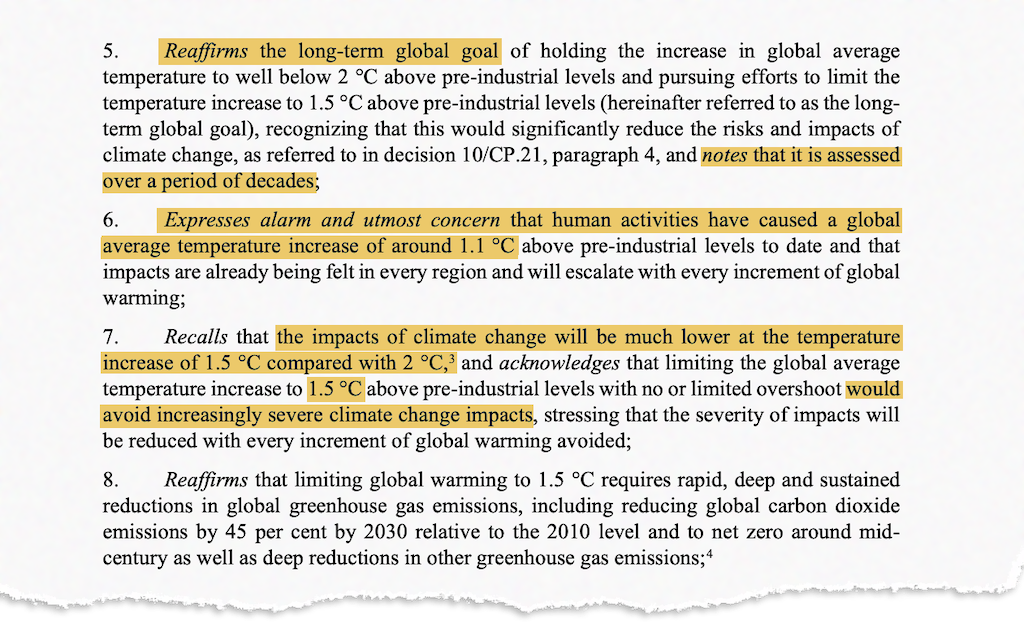
It notes that the world is “not collectively on track” to limit temperatures in line with this target. Furthermore, it notes that “some parties” have failed to meet their pre-2020 commitments.
COP29 in 2024 will decide whether to hold a third periodic review.
The first periodic review, held during 2013-2015, was a key input to COP21 in Paris, where the global temperature target was updated to include 1.5C for the first time.
Discussions at COP25 agreed that the second periodic review would take place from 2020-2022. However, they said it would not result in any change to the long-term global goal.
Despite this stricture, negotiations at COP27 were fraught. An initial draft text included punchy language on the “urgent” need to cut emissions, calling for a peak by 2025 and net-zero by 2050.
#COP27 draft text
— Simon Evans (@DrSimEvans) November 10, 2022
Some pretty punchy draft text here on 1.5C & need for “urgent action across all sectors & covering all GHGs” – and it isn’t bracketed
Parts are copied from Glasgow Climate Pact but I think (could be wrong) the ref to sectors is new?https://t.co/3bUkepbGPF pic.twitter.com/c0mTnX1vne
Later drafts significantly scaled this back, with some parties pushing to weaken the renewed emphasis on 1.5C that had been agreed at COP26 in Glasgow.
There were also disagreements over how to describe the benefits of 1.5C. The draft text, which had talked of 1.5C avoiding “increasingly catastrophic impacts”, was later revised.
China and Saudi Arabia pushed for a change to “adverse impacts”. The agreed language says staying below 1.5C would avoid “increasingly severe” impacts, relative to 2C.
Ultimately, the text aligns with the overarching COP27 “cover decision” (see above), effectively reiterating the language of the Glasgow pact from COP26.
The text also nods to the fight over who should take first responsibility for cutting emissions, calling on developed countries to “provide enhanced support” to help others. It states:
“[The COP] notes that parties have different responsibilities, national circumstances and capabilities to contribute to achieving the long-term global goal, while the impacts and risks associated with warming are unevenly distributed, and in this regard, also notes the need for enhanced efforts towards achieving the long-term global goal, taking into account ambition, equity, just transition and the best available science.”
One important line in the agreed text is to note that the Paris limits are “assessed over a period of decades”. Scientists have long argued this point and now it has been formally recognised.
Common metrics
The long-running fight over how to count emissions from gases other than carbon dioxide (CO2) rumbled on at COP27. Debate centres on the “global warming potentials” (GWPs) that are used to convert emissions from different greenhouse gases into uniform CO2 equivalents.
The negotiations over “common metrics” concerns how to convert emissions from greenhouse gases, such as methane and nitrous oxide, so that they can be counted on an equal footing.
Under the UN climate convention, developed countries must report their emissions using GWP figures from the fourth assessment report of the Intergovernmental Panel on Climate Change (IPCC) published in 2007. Developing countries can use the older values from the second assessment published in 1995.
This has significant implications for the weighting of non-CO2 emissions. Over a 100-year time period methane has GWP of 21 in the second assessment report and 25 in the fourth assessment. This rises to 28-34 in the fifth assessment and 27-30 in the sixth assessment, published in 2021.
Confusingly, parties must use values from the fifth assessment when they submit reports under the Paris Agreement. Consequently, some have called for the reporting rules to be harmonised.
At COP27, parties asked the IPCC to present its latest sixth assessment report findings at the next intersessional meeting in Bonn in June 2023. They agreed to further discuss the matter in 2027.
They also agreed that until they decide otherwise, all parties must start using the GWP figures from the IPCC’s fifth assessment report for reporting under the convention, as well as under Paris. Those still using earlier values will need to make the switch by the end of 2024 at the latest.
The COP will “consider the need” to update the GWPs used for reporting “no later than 2028”.
Action for climate empowerment
Action for Climate Empowerment (ACE) aims to empower all members of society to engage in climate action through six main mechanisms – education, training, public awareness, public participation, public access to information, and international cooperation.
A new “Glasgow ACE work programme” was agreed at COP26 and negotiations at COP27 centred on a report from its first year. They also agreed a new four-year “action plan” on the ACE agenda.
This plan “focuses on immediate action through short-term, clear and time-bound activities”. It includes activities such as identifying good practice for bringing the ACE agenda into the work of the UN climate regime and into national climate plans and policies.
Gender and climate
COP25 in Madrid had seen parties launch a five-year “gender action plan” (GAP), intended to “support the implementation of gender-related decisions and mandates in the UNFCCC process”.
The plan is an extension to one agreed at COP20 in Lima, Peru, which “seeks to advance women’s full, equal and meaningful participation and promote gender-responsive climate policy and the mainstreaming of a gender perspective”.
At COP27, the ongoing action plan was to be reviewed and its activities potentially amended. Disagreement centred on the provision of additional resources to support implementation.
The agreed text “underscores” the need for gender balance in the UNFCCC process and “invites” future COP presidencies to nominate women as “high-level champions”.
It also “invites” parties to promote gender balance in their national delegations. (Carbon Brief analysis has found that around two-thirds of delegations at recent COPs have been male.)
The COP27 cover decision also “encourages” parties to “fully implement” the action plan.

Around the COP
International pledges
Fossil fuels and renewable energy
The need to phase out fossil fuels and transition to renewable sources of energy was a major theme at COP27 – causing fireworks in the last-gasp negotiations about the summit’s final agreement, as well as in plenary rooms and during civil-society protests.
But, outside of the formal negotiations, some nations discussed the need to phase out fossil fuels through several multi-country initiatives.
This included the Beyond Oil and Gas Alliance (BOGA), a small group of nations led by Denmark and Costa Rica that have committed to a “managed phase out” of oil and gas production in order to meet the world’s climate goals, which first launched in 2021 at COP26.
On Thursday 17 November, BOGA held a packed-out side event where they renewed their call for more countries to join them in committing to an oil-and-gas phase-out. Drawing a round of applause from the audience, Denmark’s climate minister Dan Jørgensen said:
“Let me be clear, we are not calling for a sudden disruption of energy supplies. But we must equally recognise that the energy crisis is driven by the dependency on fossil fuels. The risks associated with oil and gas have been exposed like never before.”
It’s BOGA time! Whoops and cheers at #COP27 as Denmark renews calls for countries to move away from oil and gas (first launched at #COP26)
— Daisy Dunne (@daisydunnesci) November 16, 2022
“BOGA’s mission is more relevant than ever” in light of Russia’s invasion of Ukraine, Denmark says
Portugal to join @beyondoilgas today pic.twitter.com/F5mKXVaFFf
At the event, BOGA announced that Portugal and Washington State in the US were to join Denmark, Costa Rica, France, Greenland, Ireland, Quebec, Sweden, Wales in becoming “core members”. (Portugal was previously an “associate member”.)
It also announced that Fiji, Kenya, Chile and Tuvalu had decided to become “friends of BOGA”. (Other friends include Italy, Finland and Luxembourg.)
(“Core members” of BOGA have committed to ending new licensing for oil and gas exploration and extraction, plus set an end date for production in line with the Paris Agreement. Meanwhile, “friends of BOGA” are those that “support” the alliance, but have either no responsibility for licensing or no plans to take more radical steps.)
Co-leader Costa Rica was noticeably absent from BOGA’s side-event. Climate Home News reported that the country’s new administration has distanced itself from the initiative.
Tuvalu also became the first country in the world to endorse the Fossil Fuel Non-Proliferation Treaty Initiative, which aims to trigger a global fossil-fuel phase-out through the establishment of an international treaty, in a similar way to the Treaty on the Non-Proliferation of Nuclear Weapons.
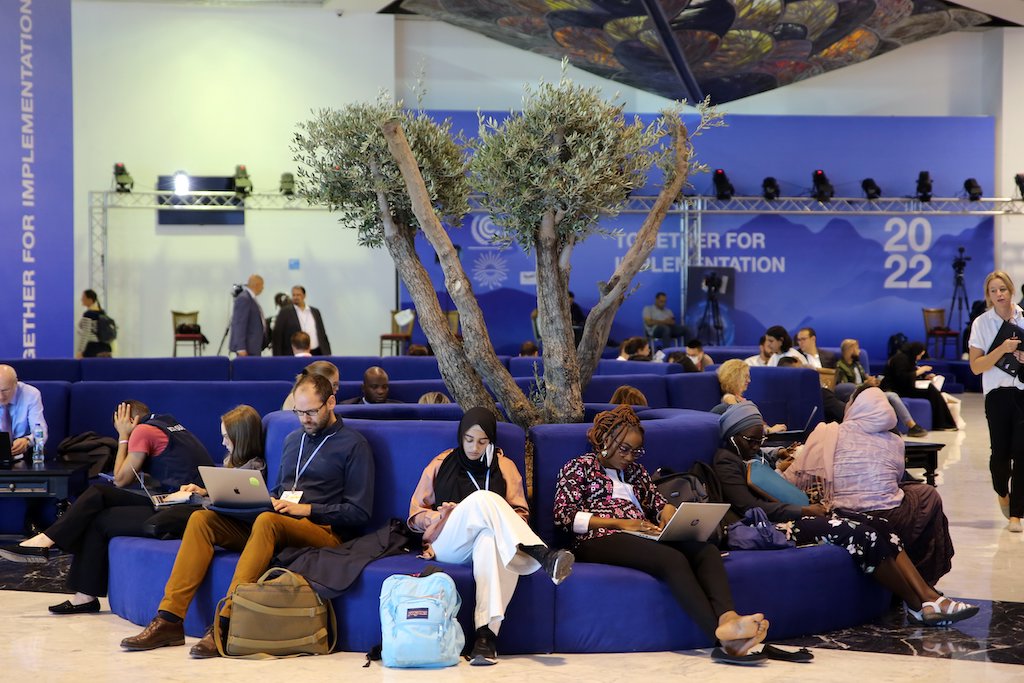
Unlike at COP26, there were few new announcements on multi-country efforts to phase-out coal-fired power, the single largest driver of global temperature rise.
In a statement released on COP27’s Energy Day, the UK COP26 presidency reiterated commitments made by countries in Glasgow to move away from coal power, saying this is the “only” way to keep the 1.5C temperature goal “within reach”.
The UK also announced a new $20bn plan, along with other G20 nations, to help major coal country Indonesia transition to using renewable energy.
According to a US spokesperson, this plan represents “probably the single largest climate finance transaction or partnership ever”, reported Euro News. (See “climate finance” for more information.)
Elsewhere in the conference, several side events, protests and press conferences focused on fears that there will be a “dash for gas” in Africa.
Some African leaders have been hoping to exploit Europe’s need for alternative gas supplies following Russia’s invasion of Ukraine, by developing their own fossil-fuel sectors.
They argue that they should be able to use their resources and bring benefits to their people, many of whom lack reliable power supplies, just as nations in the global north have.
African ministers at a #COP27 German event on the energy transition are adamant about the role of fossil fuels in their countries.
— Josh Gabbatiss (@Josh_Gabbatiss) November 15, 2022
Irene Batebe, 🇺🇬 energy minister says Uganda low rates of power access and needs investment in solar, geothermal, hydro “but also oil and gas”
1/ pic.twitter.com/sSEkT86nLl
However, at COP27, African activists pushed back hard against this narrative pointing out that renewables are a cheaper and faster option to provide the continent with reliable power. Nigerian activist Babawale Obayanju said his nation should be “an example” to others, stating that its fossil-fuel sector had brought few benefits to ordinary people.
According to a report published by a coalition of African NGOs, the majority of oil-and-gas developers operating in Africa are foreign companies.
An analysis of all multi-country energy deals agreed at COP by several NGOs found that agreements on renewables, such as solar and wind, outnumbered those for gas.
Gas v clean energy deals at #COP27 – tracked by a number of NGOs at the talks. Some gas pieces may be behind scenes but as it stands the wind / solar / green hydrogen list is longer… https://t.co/9uKz0nLdFJ pic.twitter.com/BknQJ6E24Z
— Ed King (@edking_I) November 17, 2022
In addition to scrutiny of fossil-fuel producing countries, oil companies themselves were taken to task at COP27 through a UN initiative called the “high-level expert group on the net-zero emissions commitments of non-state entities”, often referred to as “HLEG”.
Started at the request of the UN secretary-general António Guterres in March 2022, the “anti-greenwashing” group was tasked with producing 10 recommendations for what businesses, cities and financial institutions must do to ensure their net-zero emissions pledges are legitimate.
Presenting the findings at a packed-out event during COP27’s first week, the group’s chair, Canada’s former environment minister Catherine McKenna, said:
“Too many of these net-zero pledges represent little more than empty slogans and hype. You cannot be a net-zero leader while continuing to build or invest in fossil fuel supply.”
Catherine McKenna launches recommendations from UN SG’s High Level Expert Group on finance. The aim is to prevent delay, obfuscation and greenwashing. #COP27 pic.twitter.com/SULFori7rX
— Kate Levick (@KateLLevick) November 8, 2022
Guterres added:
“Let’s tell it like it is. Using bogus ‘net-zero’ pledges to cover up massive fossil fuel expansion is reprehensible. It is rank deception. This toxic cover-up could push our world over the climate cliff. The sham must end.”
Speaking to Climate Home News, Will Aitchison at InfluenceMap, a group tracking corporate lobbying, described the findings as a “watershed moment”. He added:
“These recommendations break new ground in setting expectations not just for companies, but also for powerful third parties like industry associations.”
However, Prof Joeri Rogelj, a lead Intergovernmental Panel on Climate Change (IPCC) author and climate scientist at Imperial College London, pointed out in a Twitter post that the group’s main recommendation “seemingly confuse[s] net-zero CO2 and net-zero GHG dates”. (Pathways for 1.5C assessed by the IPCC reach net-zero CO2 emissions by 2050, rather than net-zero greenhouse-gas emissions.)
Quite a disappointment to see the @UN Secretary General’s high-level expert group on net zero chaired by @cathmckenna seemingly confuse net zero CO2 and net zero GHG dates in their main recommendation. @antonioguterres, where did it go wrong? pic.twitter.com/2qTpHajhHf
— Joeri Rogelj (@JoeriRogelj) November 9, 2022
In addition to the UN initiative, the UK government’s Transition Plan Taskforce also launched a “gold standard for best practice climate transition plans” for private-sector firms.
Methane
Methane – the greenhouse gas most responsible for climate change after CO2 – once again became a buzzword for developed countries speaking at COP27.
In his special address to COP27 on 11 November, US president Joe Biden described action on methane, a short-lived but highly potent pollutant, as one of the “climate gamechangers” that the US is trying to “rally the world behind”.
President Biden: The US is “rallying the world around climate gamechangers” such as the global methane pledge and international efforts to stop deforestation and restore ecosystems pic.twitter.com/Xdix2zr8zh
— Daisy Dunne (@daisydunnesci) November 11, 2022
He also used his address to tout his country’s newly announced rules for slashing methane from domestic oil and gas production.
This was followed on 17 November by an update to the global methane pledge – a multi-country initiative to slash methane emissions by 30% by 2030 first launched at COP26 and spearheaded by the US and the EU.
Speaking during a ministerial meeting alongside vice-president of the European Commission Frans Timmermans and COP27 president Sameh Shoukry, US special climate envoy John Kerry announced that 150 countries had now agreed to the pledge. (At its launch at COP26, the US estimated that 80-100 countries were signed up.)
“We are turning a methane moment into momentum. This is absolutely critical for keeping 1.5C in reach,” @ClimateEnvoy John Kerry
— Daisy Dunne (@daisydunnesci) November 17, 2022
150 countries have now endorsed the global methane pledge, he says. (At launch at #COP26 he said 80-100 countries had signed up.) pic.twitter.com/rc7NbUSGVu
Kerry added that, as well as tackling methane emissions from oil and gas production, committed countries would also begin to tackle methane from waste and animal agriculture, including through efforts to change the “diets of cattle”. (Scientists are clear that people living in the global north will need to cut back meat consumption if the world is to meet its climate goals.)
New signatories since COP26 include Australia, Egypt and Qatar.
China, the world’s largest annual methane emitter, is not signed up to the pledge. However, China’s special climate envoy Xie Zhenhua made a surprise appearance at the session and told the audience that the country has drafted its own national methane strategy. (See the “China at COP27” section.)
After leaving the stage, John Kerry has just interrupted the methane ministerial meeting to introduce his “friend” China’s special envoy Xie Zhenhua. Seems an unscheduled surprise to panelists. China is not a member of the Global Methane Pledge #COP27
— Joe Lo (@joeloyo) November 17, 2022
Reacting to the update on the global methane pledge, campaigners called for countries to go further to turn pledges into action.
In a statement, Kim O’Dowd, campaigner at the Environmental Investigation Agency, a UK NGO, said:
“What the world desperately needs now are real actions and commitments – something far more meaningful to address the ongoing crisis. We cannot wait for another climate summit to deliver on the promises made with the global methane pledge.
“Negotiations for a global methane agreement have to start now, with concrete and binding objectives, mandatory reporting, monitoring and verification, national actions plans and targeted financial support to ensure implementation.”
Elsewhere at the conference, a report released by the Institute for Agriculture and Trade Policy (IATP) and the Changing Markets Foundation found that the combined methane emissions of 15 of the world’s largest meat and dairy companies are higher than those of several of the world’s biggest methane emitters, including Russia, Canada and Australia.
Deforestation
Several countries put forward new international initiatives aimed at stopping deforestation and restoring ecosystems at COP27.
In the first week, the UK announced the arrival of the forests and climate leaders’ partnership, a group of 26 countries – representing a third of the world’s forests – that will meet twice yearly to “track commitments” on efforts to “halt and reverse forest loss by 2030”.
The initiative is designed to build on the Glasgow forests and land use declaration made last year at COP26. However, as Climate Home News noted in its reporting, this agreement had the backing of 145 nations representing over 90% of the world’s forests – suggesting most nations declined to up their deforestation commitments by signing on to the new initiative.
UK prime minister Rishi Sunak held a special event at COP27 to announce the initiative alongside Dutch prime minister Mark Rutte, Egyptian prime minister Dr Mostafa Madbouly and Senegal president Macky Sall.
However, Sunak caused momentary global panic when he appeared to spontaneously sprint out of the room during the announcement – as captured by Carbon Brief’s editor Leo Hickman.
UK prime minister @RishiSunak has just been rushed out of the room by his aides during the middle of the launch for forests partnership at #COP27 pic.twitter.com/OQy9TYkqpX
— Leo Hickman (@LeoHickman) November 7, 2022
(A spokesperson for 10 Downing Street later claimed Sunak left after a “late decision” to meet with representatives from Germany and South Africa.)
Elsewhere, France also announced a new initiative to protect areas high in “carbon and biodiversity”, such as “ancient forests, peat bogs or mangroves”.
Backed by the US and China, France said it would like to work with countries to form “positive conservation partnerships” with rainforest nations. Costa Rica, Colombia, Gabon and the Philippines affirmed their interest in being partners, France added.
Another headline-grabbing initiative was a new pact between Brazil, Indonesia and the Democratic Republic of the Congo (DRC), dubbed the “Opec of rainforests” by campaigners. The three nations are home to half of the world’s tropical forests.
Widely trailed at COP27, but signed in Indonesia ahead of the G20 meeting of nations, the new pact agrees that the three countries should be paid to tackle deforestation and boost carbon stores in their forests, Reuters reported.
It also says that the countries will work to negotiate “a new sustainable funding mechanism” to help developing nations preserve their biodiversity and to increase funding through the UN’s REDD+ programme for cutting deforestation.
Prior to signing, DRC environment minister Eve Bazaiba told reporters:
“South-to-south cooperation – Brazil, Indonesia, DRC – is very natural. We have the same challenges, the same opportunity to be the solution to climate change.”
During his speech to COP27, incoming Brazilian president Luiz Inácio Lula da Silva promised that the new alliance would be “strengthened under my government”.
Lula🇧🇷:
— Daisy Dunne (@daisydunnesci) November 16, 2022
🌴Recommits Brazil to reaching “zero deforestation”
🌴Will create a “ministry of Indigenous and native peoples” to ensure “dignity, peace, sustainability” for land defenders
🌴Germany & Norway “reigniting” Amazon fund after his victory pic.twitter.com/1l3044zbdy
Speaking to Carbon Brief at the sidelines of COP27, Prof Simon Lewis, a leading forest scientist at University College London and the University of Leeds, said that the new alliance had the potential to make a “very powerful” impact on deforestation rates. He explained:
“If you look at deforestation indicators for Indonesia and Brazil, it’s like a see-saw: when one falls, international demand just shifts to the other region.”
A strategic alliance could in theory help the rainforest nations to better manage and control this international demand, he added.
Agriculture
For the first time ever, COP27 hosted pavilions dedicated solely to food and agriculture. It was an attempt to turn the spotlight on the relationship between climate change and food systems in the middle of a global food crisis.
The conference’s blue zone housed three different stages for food: a Food and Agriculture pavilion set up by the Food and Agriculture Organization (FAO), CGIAR and the Rockefeller Foundation; a food systems pavilion; and a Food4Climate pavilion by ProVeg International that attracted delegates looking for oat milk to go with their coffee.
The Egyptian presidency and the FAO jointly launched the Food and Agriculture for Sustainable Transformation Initiative (FAST), which aims to improve the “quantity and quality of climate finance contributions” towards food systems by 2030 and to “support adaptation and maintain a 1.5C pathway whilst supporting food and economic security”.
According to FAO deputy director-general Maria Helena Semedo, while climate finance has increased over the past decade, the share going to agriculture has been steadily decreasing.
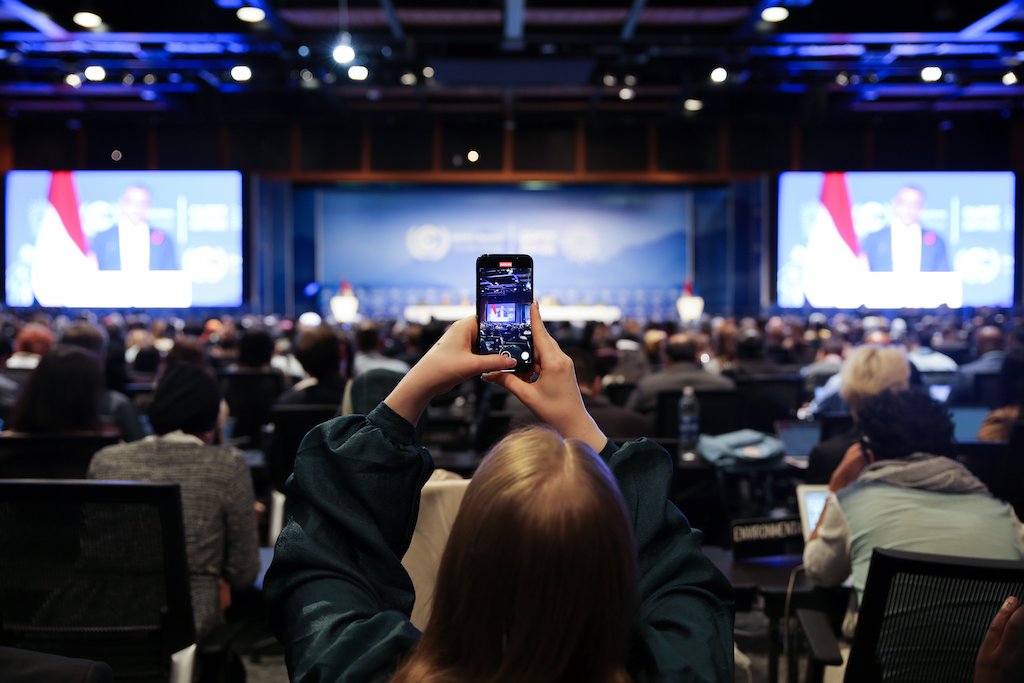
Separately, the US, EU, Norway, Germany and the Netherlands announced an additional $135m of funding for fertiliser and soil-health programmes in sub-Saharan Africa and in “key middle-income countries”.
The funding is part of US president Joe Biden’s Global Fertiliser Challenge that was launched to “address the global fertiliser shortages” sparked, “in part, by the war in Ukraine”.
Another closely watched initiative was the US and COP28 host UAE’s Agricultural Innovation Mission for Climate, which is also referred to as AIM4C or AIM4Climate.
AIM4C says that it hopes to boost investment “and other support” for “climate-smart agriculture and food systems innovation over five years (2021-25)” to the tune of $8bn. On 12 November – Agriculture Day at COP27 – AIM4C held a high-profile ministerial hosted by the Egyptian presidency, with an invitation to the private-sector to raise resources.
However, DeSmog pointed out in an investigation that AIM4C was “bias[ed] towards industry-friendly climate initiatives such as precision farming, carbon farming and lowering the methane in cow burps”.
The outlet highlights that US agriculture secretary Vilsack was “a former CEO of a major dairy industry lobbying firm” who had launched initiatives such as “dairy net-zero” at COP27.
Action Aid’s Teresa Anderson said that both US initiatives are emissions-heavy, technology-focussed and chemical fertiliser-friendly. They intend, she said, to give delegates the impression that “the real heroes feeding the world are tech bros in suits and lab coats generously scattering their brilliance onto the needy farmers of the world.” She told Carbon Brief:
“Launching these programmes during climate negotiations feels like all that they need to do to get a climate veneer, a very thin one. They’re trying to climate-wash their climate-harming initiatives by launching them during COP. Aim for climate, but fail miserably.”
Global leaders and country pledges
In addition to trying to influence negotiations behind the scenes, countries also used COP27 as an opportunity to lay out their own positions and actions on climate change.
The first major occasion for this was the world leaders summit, held on the Monday and Tuesday of COP27’s first week.
Unlike at COP26, this year’s world leaders summit did not see a flurry of new national pledges and initiatives for cutting greenhouse gas emissions.
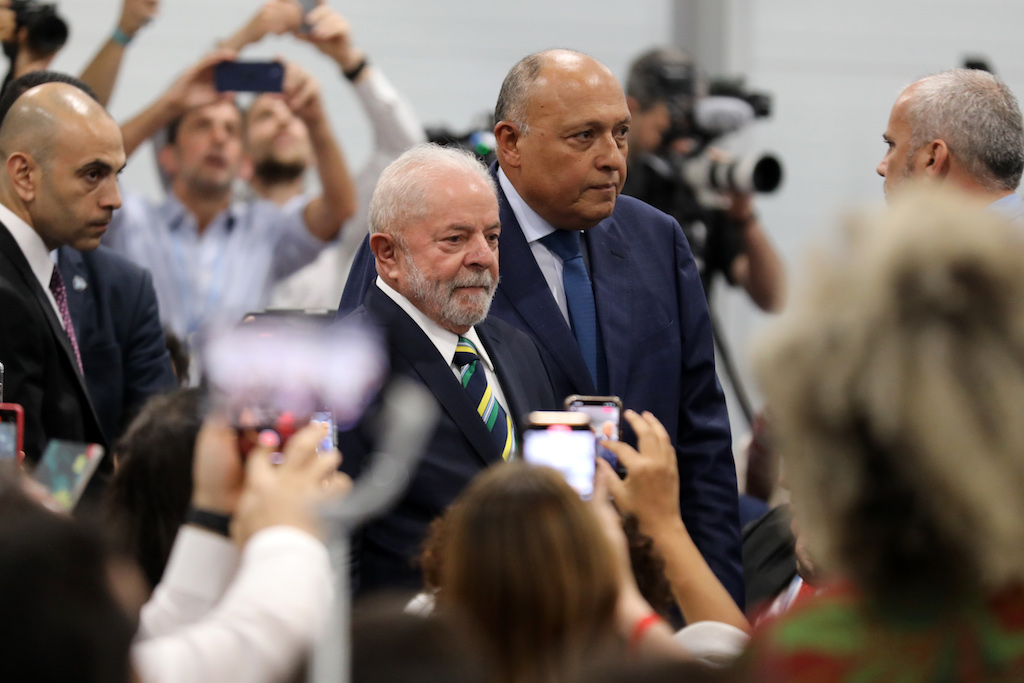
Instead, many developed nations used their addresses to stress their commitment to tackling climate change despite energy security concerns driven by Russia’s invasion of Ukraine. (See: Russia’s war.)
Most developing nations, meanwhile, used their speeches to stress the severity of the climate impacts they are already experiencing and to express disappointment over developed countries’ failure to meet the 2009 promise to deliver $100bn in climate finance by 2020.
Mia Mottley, the prime minister of Barbados, emerged as a particularly vocal advocate for developing nations – particularly on the need for rich nations to provide financial assistance to those suffering from the loss and damage caused by climate change (see: Loss and damage).
“We have the power of choice. We must choose to act.” This was my message today at the Sharm El-Sheikh Climate Implementation Summit Opening Ceremony at #COP27. I believe that it is only through using our power of choice, to act, that we can truly address this climate crisis. pic.twitter.com/hGE3ZZbRxG
— Mia Amor Mottley (@miaamormottley) November 8, 2022
Addressing the world leaders summit on 8 November, she said:
“My friends, time is running out on us…We have the power to act or we have the power to remain passive and do nothing.”
The world leaders summit clashed with US midterm elections, but president Joe Biden was invited by Egypt to give a “special address” a few days later on 11 November.
The arrival of the world’s second-largest annual emitter sparked a frenzy at the conference, with some delegates queuing for hours to see Biden’s special address in person.
In a wide-ranging address, Biden apologised for his predecessor Donald Trump’s decision to withdraw from the Paris Agreement, touted his recently passed domestic climate plan (the “Inflation Reduction Act”) and announced intentions to rally the world behind restoring ecosystems and slashing methane emissions. (See: Methane.)
Somewhat expectedly, Biden sidestepped any mention of loss and damage, the climate-justice issue that dominated talks elsewhere at the conference.
No mention of #LossAndDamage in Biden’s special address to #COP27…
— Daisy Dunne (@daisydunnesci) November 11, 2022
…although he did mention US supports the Global Shield project, which other countries have spoken about in the context of loss and damage funding
(see this thread by @Josh_Gabbatiss) https://t.co/3p3deqgMKp
Reacting to his address, analysts and activists alike called for Biden to do more internationally to tackle climate change. In a statement, Ani Dasgupta, president and chief executive of the World Resources Institute, said:
“Biden’s ambitious actions at home now need to be matched by equally robust investments to advance climate action abroad. The inconvenient truth is that the US is grossly underperforming on its international climate finance commitments. While the Biden administration has consistently reiterated its $11.4bn annual climate pledge, US officials have yet to outline a credible pathway to deliver on that promise.”
(Carbon Brief analysis – featured on the frontpage of the Guardian at the start of COP27 – shows the US is falling $32bn short on its “fair share” of the $100bn climate-finance goal.)
Another leader who caused a stir at the summit was the incoming president of Brazil, Luiz Inácio Lula da Silva – who is commonly referred to as Lula.
Speaking to a packed-out room during the conference’s second week, Lula reconfirmed his commitment to achieving “zero-deforestation” in Brazil, announced plans to create a national ministry dedicated to Indigenous people and promised to use his “comeback” to force developed nations to deliver on climate finance.
Lula🇧🇷:
— Daisy Dunne (@daisydunnesci) November 16, 2022
🌴Recommits Brazil to reaching “zero deforestation”
🌴Will create a “ministry of Indigenous and native peoples” to ensure “dignity, peace, sustainability” for land defenders
🌴Germany & Norway “reigniting” Amazon fund after his victory pic.twitter.com/1l3044zbdy
He also called for COP29 in 2024 to be held in Brazil, telling delegates:
“I advocate in a very strong way that the conference should be held in the Amazon.”
His interventions were met with whoops and cheers in the room and rare praise from environmental activists. Carolina Pasquali, executive director of Greenpeace Brazil, said in a statement:
“Greenpeace Brazil celebrates knowing that the country, in the words of the president-elect, will have a prominent role on climate discussions. This is an excellent start.”
Though most countries did not make new pledges at COP27, a small handful of nations did announce new national climate plans, (known as “nationally determined contributions” or NDCs).
The EU announced plans to reduce its emissions by 57% on 1990 levels by 2030 – an increase of two percentage points on its previous pledge, which was rated as “almost sufficient” for meeting global climate goals by the research group Climate Action Tracker.
The EU has not yet submitted its updated NDC, but plans to do so imminently, vice-president of the European Commission Frans Timmermans told a press conference.
This is the Implementation COP. It’s time to deliver.
— Frans Timmermans (@TimmermansEU) November 15, 2022
The 🇪🇺 is firmly on track to finalise the legislation to deliver our climate target by the end of this year.
We expect to reach at least -57% emissions reductions by 2030 and therefore stand ready to update our NDC.#COP27 pic.twitter.com/KBO7yQ4WWp
In addition, Mexico announced new plans to slash its greenhouse gas emissions by 35% by 2030. (It is not clear what baseline Mexico is using from its updated NDC.)
It had previously pledged to reduce its emissions by 22% on “business-as-usual” levels by 2030 – a pledge described as “critically insufficient” by Climate Action Tracker.
Climate Action Tracker has not yet rated Mexico’s new pledge. However, its analysis suggests Mexico would need to cut its 2020 emissions by more than 40% by 2030 to be in line with limiting global warming to 1.5C.
Turkey, which only ratified the Paris Agreement last autumn, also announced a new NDC at COP27. It pledged to reduce its emissions by 41% by 2030, when compared to business-as-usual levels. Turkey had previously pledged to cut its emissions by 21% on BAU levels by 2030, which was rated as “critically insufficient” by Climate Action Tracker.
According to NGO analysis, Turkey’s new pledge could see it increase its emissions by more than 8% every year until 2030.
In a statement, Prof Ebru Voyvoda, from the Middle East Technical University, described Turkey’s new pledge as “largely fall[ing] short of reflecting the country’s capabilities to transform and achieve sustainable development”.
China at COP27
As the world’s largest current emitter, China’s position in the negotiations – and its promises for climate action – attracts major attention at COP every year.
During COP26 at Glasgow, China was seen as a low-key player, until, late on, it released a joint declaration with the US to increase joint efforts on climate action. The country did not have a pavilion, held very few media briefings and reportedly blocked efforts by the UK presidency to commit nations to “phase out” the use of coal.
At this year’s COP, in contrast, the China pavilion was back for the first time since COP25 in Madrid. It hosted a wide range of events on topics such as green finance, low-carbon transition and the development of China’s emission trading scheme. The country’s climate envoy Xie Zhenhua also briefed the media during both weeks of the conference, adopting a genial attitude.
However, when it came to major issues within the formal negotiations, such as loss and damage, China stuck to its familiar positions.
China’s Xie Zhenhua speaking at #COP27
— Leo Hickman (@LeoHickman) November 9, 2022
“It is for the US to clear the barriers [created by Pelosi’s Taiwan visit]…But I have already started informal contact with John Kerry here…We have already exchanged 8 letters [before arriving]…We are old friends.” pic.twitter.com/D04VWLcmIr
During the first week, Gaston Browne, the prime minister of Antigua and Barbuda, speaking on behalf of the AOSIS negotiating bloc, demanded China and India pay for climate damages, given they are both major emitters. He said: “I don’t think that there’s any free pass for any country and I don’t say this with any acrimony.”
China is currently a “non-Annex I” party under the convention agreed in the early 1990s, a category mostly consisting of then-developing countries. The convention set out the principle of “common but differentiated responsibility and respective capabilities” (CBDR), which asked developed countries to take the lead in mobilising climate finance and assisting developing countries to both mitigate against and adapt to climate change.
The principle was reaffirmed by the Paris Agreement in 2015, but it has long caused debates about whether China should continue to be categorised as a developing country, given its economic growth and volume of emissions over the past three decades.
On the issue of loss and damage, Xie told the media at COP27 that China “supports the claims on loss and damage made by developing countries” and, given that China was also hit by extreme droughts and floods over the past year, the country “feels what vulnerable developing countries felt and, hence, we strongly support their demands”.
However, Xie reinforced China’s position that it is a developing country and said that the country is not obligated to provide financial assistance to poor nations, citing CBDR.
Xie said that, in the past year alone, extreme droughts and floods have cost China “400bn Chinese yuan [$56bn] and more than 4,000 deaths”. He said China is willing to help developing countries increase its capacities for mitigations and adaptations “through South-South cooperation” and, if a loss-and-damage fund were to be agreed at COP27, developing countries should only contribute “on a voluntary basis”.
Li Shuo, a Beijing-based policy adviser for Greenpeace, told Carbon Brief:
“In the past when we talked about China’s climate action, we focused more on its effort in mitigation. With the establishment of a loss-and-damage fund at COP27, it has become obvious that, from now until 2025, the discussion over who should donate to climate finance will become a contentious as well as highly politicised issue. China should think about its role in this issue and get prepared for the possible political division.”
Belinda Schäpe, policy advisor from the climate diplomacy team at E3G, tells Carbon Brief:
“The decision text at COP raised the pressure on China, as the third largest historic emitter after the US and the EU, to step up on financing towards loss and damage. At COP27, some small island states have publicly called on China to pay for loss and damage. China has said that it is open to voluntary contributions through existing mechanisms and it has already pledged $3.1bn through its fund on south-south cooperation on climate change back in 2015. As a responsible power and a climate leader, China could, and should, take its support for vulnerable countries to the next level.”
A year earlier at COP26 in Glasgow, the US-China joint declaration was seen as a major breakthrough. The world’s two largest emitters published a “joint climate declaration” and made promises to cooperate on a wide range of issues, including an intention to establish a “working group” on climate action.
However, bilateral cooperation between the two countries, including climate talks, was suspended in August this year after outgoing US House of Representatives speaker Nancy Pelosi visited Taiwan, over which China claims sovereignty.
During COP27, there was constant attention on whether China and the US could break their deadlock on climate cooperation.
At the start of the meeting, delegations from both sides attempted to channel positive signals through the media. In a conversation at the Council on Foreign Relations ahead of COP27, US climate envoy John Kerry said that he hoped that action on climate change “should not be part of the bilateral differences” between China and the US and the two countries “need to get back to the table because the world depends on it”.
In response, China’s climate envoy Xie Zhenhua said during his press briefing at the start of COP27 that he and Kerry have enjoyed a 25-year friendship and had maintained informal contacts – an exchange of “eight letters” – since the suspension of formal talks in the summer. He also said that the two parties had “already started private conversations for the success of COP27”, emphasising that the “door is always open” on China’s side.
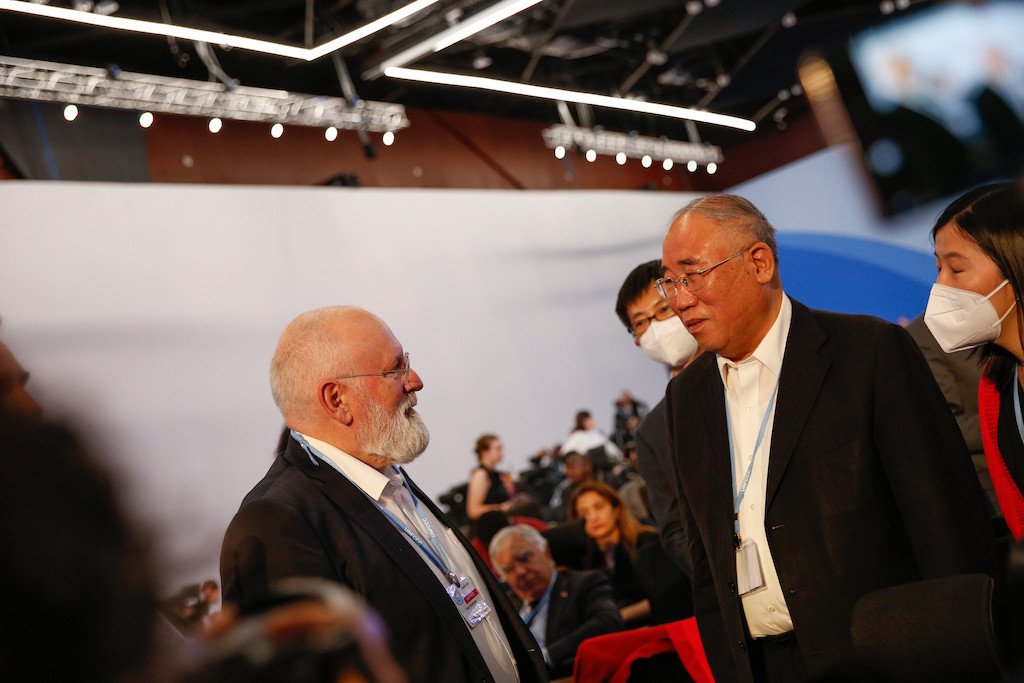
Optimism continued in the second week as Chinese president Xi Jinping and his US counterpart Joe Biden shook hands at the G20 summit in Bali, Indonesia. The White House said that the two countries “must work together to address transnational challenges – such as climate change, global macroeconomic stability including debt relief, health security, and global food security”, and the two leaders agreed to “empower key senior officials to maintain communication and deepen constructive efforts on these and other issues”.
A statement released by China’s Ministry of Foreign Affairs also addressed that it is in the two countries’ mutual interest to “promote post-Covid global recovery, tackle climate change and resolve regional issues through China-US coordination and cooperation”, and that China and the US would jointly work for the success of COP27.
Bernice Lee, executive director of the Hoffmann Centre for Sustainable Resource Economy at Chatham House, told Carbon Brief:
“It is obviously important that the world’s two largest polluters demonstrate that they are willing to work together despite their differences, so I think what they are saying sends a positive signal. Of course, we need them to be more consistently collaborative and competitive in terms of the ‘Race to the Top’, because, ultimately, it should be something that is imperative when it comes to climate action, and they should find the space despite the differences to work together over a longer period of time.”
David Sandalow, a senior energy official in the Obama and Clinton administrations in the US and the lead author of a recently released Guide to Chinese Climate Policy, told Carbon Brief:
“It was encouraging to see the US and China resume official climate dialogue last week. When the US and China work together on climate change, they can help move the multilateral negotiations forward and deliver results in other arenas as well. The US-China Glasgow Declaration from a year ago set forth a framework for joint dialogue, with a focus on methane emissions and other topics where bilateral action is especially promising. In the months ahead, I hope the two delegations will consider topics including climate finance, each country’s vulnerability to climate change and support for low-carbon development in third countries.”
During the first week of the conference, Xie also announced that China has now drafted a national action plan for methane reduction, focusing on three sources of emissions: oil and gas, farming, and waste. As part of the China-US joint pledge in Glasgow, the two countries had agreed to slash their methane emission, but the deal was suspended along with other bilateral talks in August.
Xie even paid a surprise visit three days before the negotiations ended to a ministerial meeting of the Global Methane Pledge led by the US and the EU. Launched at COP26, the Global Methane Pledge now has 130 participants, which are committed to reducing 30% of global methane emissions at 2020 levels collectively by 2030. China has not yet signed the pledge, but Xie said China has “a little bit of a way to go so we can do surveillance and collect statistics as well as verification of our baseline”.
Shortly after COP27 concluded, John Kerry said in a lengthy statement that, due to the compressed time during negotiations, China and the US “unfortunately were able to make only limited progress”.
But he said he appreciated Xie’s attendance at the Global Methane Pledge event, adding that China and the US are now “back at the table to try and follow through on, and build upon, our mutual commitments in the Joint Glasgow Declaration, including China’s commitments on phasing down coal consumption, taking action to reduce methane emissions in the 2020s, and addressing illegal deforestation”.
Kerry continued by saying that the climate crisis is “fundamentally a global, not a bilateral, issue”. He added:
“Reducing emissions in time is about math, not ideology. That’s why all nations have a stake in the choices China makes in this critical decade. The US and China should be able to accelerate progress together, not only for our sake, but for future generations. And we are all hopeful that China will live up to its global responsibility.”
Xie is quoted by Reuters saying on the final full day at COP27 that the US-China dialogue at the event had been “candid, friendly, positive and active” and that “overall it’s been very positive”.
Protests, access and harassment
Concerns over protester safety, access, surveillance and harassment cast a large shadow over proceedings in Sharm el-Sheikh – with several delegates privately telling Carbon Brief that it was the “worst COP ever” for activists and civil society.
In the months leading up to COP27, activists and developing-country delegates raised concerns about sky-high accommodation costs.
According to a letter seen by Climate Home News, the Egyptian Hotel Association ordered hotels to set a price of at least $500 per night for a room in a five-star hotel – almost five times the usual cost – at least $350 a night for a four-star hotel and $120 for a two-star.
Activists and journalists alike faced further accommodation problems once arriving in Egypt. Several told Carbon Brief that they arrived at their hotels and were immediately asked to pay additional room fees, forcing them to seek accommodation elsewhere.
Bloomberg reported that “as many as 80 young activists were crammed into dirty rooms full of cigarette ends, some without locks, and were awoken in the middle of the night by hotel personnel asking for their identification”.
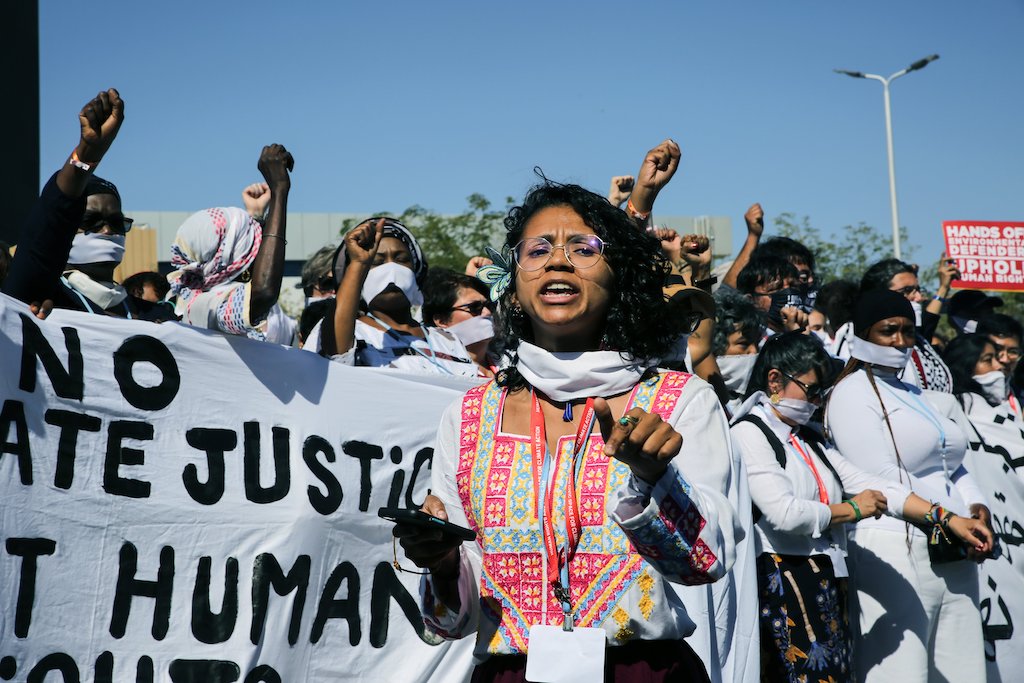
Responding to concerns over hotels, Wael Aboulmagd, special representative for the Egyptian COP27 presidency, told a press briefing that his office was “aware” of incidents and was “asking people to bring cases to us as rapidly as possible so we can interfere”, while also looking to get to “the root of the issue”.
Elsewhere, Politico reported on concerns from cyber security experts that Egypt’s COP27 summit app – which offered information such as meeting times and venue maps – could be used to spy on delegates.
When downloaded on an Android phone, the app allegedly has the capability “to hack private emails, texts and even voice conversations”, according to experts who reviewed the app for Politico.
Responding to reports of the COP27 app being used for spying, Aboulmagd told journalists that it was an “[un]substantiated” allegation and that he had been informed it would be “technically and physically impossible” for the app to be used for such purposes.
Safety concerns – along with strict protest laws in Egypt – had a dampening effect on demonstrations held outside of the COP27 venue, which are usually a major feature of UN climate summits.
A historic moment at #COP27 – the first UN-sanctioned climate march led by Sanaa Seif, sister of Egyptian-British jailed activist Alaa Abdel-Fattah, @chilledasad100 @mitzijonelle & more pic.twitter.com/skTSIDbmTf
— Daisy Dunne (@daisydunnesci) November 12, 2022
However, history was made at COP27 on the first Saturday – the traditional protest day – when activists were granted permission to march inside the delegates-only area of the conference (the “blue zone”) for the first time ever at a UN climate summit.
A crowd of several hundred people – (much smaller than the 100,000 people that descended on Glasgow during COP26) – marched across the blue zone’s outside area carrying placards mainly focused on funding for loss and damage and keeping the 1.5C temperature goal within reach.
The procession was led by Sanaa Seif, sister of Egyptian-British jailed activist Alaa Abdel-Fattah. Seif spoke numerous times at COP27 to call for her brother’s release, including at an event where she was heckled by an Egyptian MP – who was escorted out of the room by UN security.
Others at the front of the procession included Mitzi Jonelle Tan, a climate-justice activist from the Philippines, Asad Rehman, the UK activist who directs the anti-poverty charity War on Want, and Hindou Oumarou Ibrahim, an Indigenous environmental activist from Chad.
Speaking privately to Carbon Brief, civil society sources suggested that they had been encouraged by the UN to apply for permission to march inside COP27’s blue zone amid difficult conditions for protesters in Egypt.
In a statement to Carbon Brief, the UNFCCC confirmed that the decision to allow protesters to march inside the blue zone was unprecedented, but did not comment on why it was made.
“Leaders from global-north countries responsible for the vast amount of emissions heating our planet are already breaking promises made just months ago at COP26”
— Daisy Dunne (@daisydunnesci) November 8, 2022
Vanessa Nakate @vanessa_vash among young climate activists calling for end to new fossil fuels at sidelines of #COP27 pic.twitter.com/2gFq8MP78X
Several other days at COP27 saw small-sized protests take place outside plenary halls and meeting rooms.
In the conference’s first week, Ugandan climate activist Vanessa Nakate gathered with other young protesters to call for global-north leaders to commit to ending fossil fuels. She told a small huddle of journalists:
“Leaders from global-north countries responsible for the vast amount of emissions heating our planet are already breaking promises made just months ago at COP26.”
Greenwashing at COP27
Allegations that major fossil-fuel countries and companies were using COP27 as a vehicle for greenwashing were rife throughout the two-week summit.
A report by the NGOs Corporate Accountability, Corporate Europe Observatory and Global Witness released during the summit found that 636 “fossil-fuel lobbyists” had registered for COP27 – an increase of 25% from COP26.
If fossil-fuel lobbyists formed a country delegation, they would be the second-largest at the summit behind the UAE, according to the analysis. (And 70 of COP28-host UAE’s delegation were classed as fossil-fuel lobbyists by the report.)
The number of fossil-fuel lobbyists was also greater than the number of country delegates from the world’s “most climate-vulnerable countries” (Puerto Rico, Myanmar, Haiti, Philippines, Mozambique, the Bahamas, Bangladesh, Pakistan, Thailand and Nepal), according to the analysis.
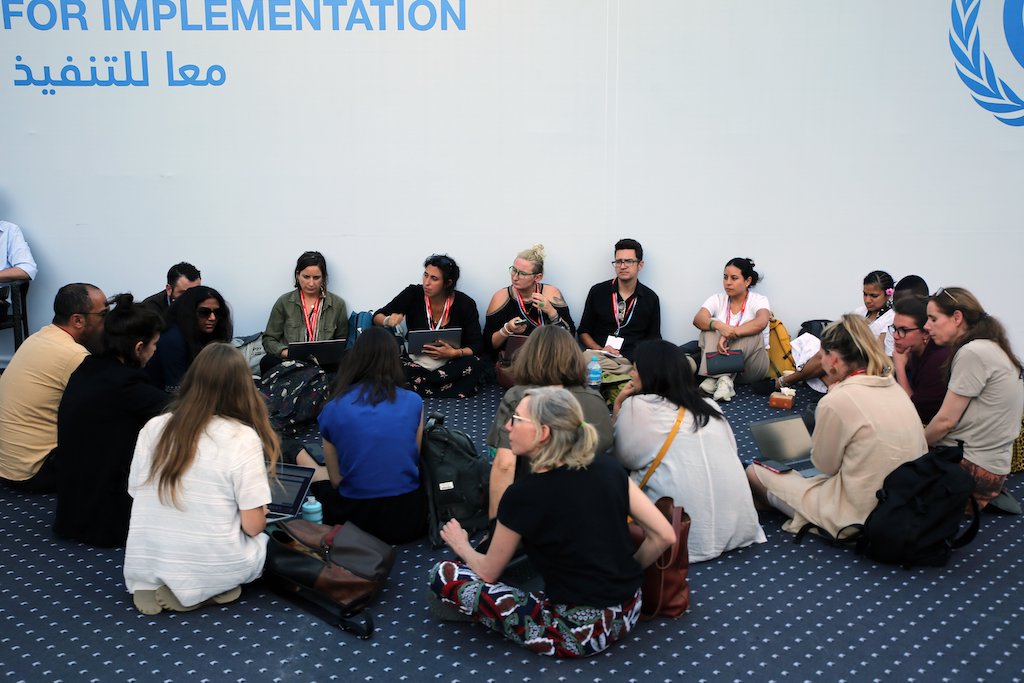
(The report came up with the 636 figure by counting the number of individuals registered either directly affiliated with fossil fuel companies or attending as members of delegations that act on behalf of the fossil fuel industry.)
An investigation by DeSmog noted that two sanctioned oil barons were among the fossil-fuel lobbyists in Russia’s delegation.
Responding to a question about the findings in a press briefing, Wael Aboulmagd, special representative for the Egyptian COP27 presidency, said that representatives of high-carbon industries were welcome to show their “best practices” during the summit’s decarbonisation day. He added that anyone from high-carbon industries would be “properly scrutinised”.
Also addressing the findings during a separate press conference, vice-president of the European Commission Frans Timmermans said he did not think it was a problem. He added:
“In my job, I’m in front of the lobbyists all the time. Lobbyists have their roles as long as you see them with clarity and you make sure you’re not steered by them.”
(A separate analysis by Desmog found that the number of representatives of the big agribusiness industry at COP27 was more than double that of COP26.)
Separately, further analysis by Corporate Accountability found that 18 out of 20 of the corporate sponsors of COP27 directly support or partner with the fossil fuel industry.
This includes the world’s largest plastic polluter, Coca Cola, the airline Egyptair and Orascom Construction, which recently built in Egypt one of the world’s largest gas-fired power plants.
The slick official #Cop27 video features two workers by an oil pump jack with the caption: “You can help give the earth a fighting chance” pic.twitter.com/WVY7iL0a1E
— Joe Lo (@joeloyo) November 2, 2022
In addition, the Financial Times reported that the PR firm behind COP27’s external communications has previously represented the fossil-fuel industry.
Elsewhere at the conference, eyebrows were raised at major oil producer Saudi Arabia’s contribution to climate communications, the “Saudi Green Initiative” – which had a physical presence both inside and outside COP27.
SGI’s pavilion space inside COP27 asked delegates how much they recycle and how much water they used to brush their teeth in the morning, noted Bloomberg reporter Akshat Rathi.
It’s Friday at #COP27
— Akshat Rathi (@AkshatRathi) November 11, 2022
Why not learn how the Saudis would like you to go green? If you can’t make it to the beach resort town of Sharm el Sheikh to find out, don’t worry. We’ll do it right here on Twitter.
PS: This is an actual Q&A at the Saudi Green Initiative. pic.twitter.com/oHuwlBMkL2
The Financial Times reported that the SGI hub, found down the road from the COP27 site in Sharm el-Sheikh, featured “luxury eco-hotel aesthetics”.
Climate Home News reported that Saudi Arabia, along with other major fossil-fuel producers such as Egypt, UAE and Canada, used their stands at the conference to advertise plans to use carbon capture and storage, a technology for removing CO2 that is still not available at scale.
In addition, Climate Home News also reported on how a UN agency had teamed up with a fossil-fuel lobbyist and “convicted fraudster” on an African energy finance initiative. The UN cancelled the project following Climate Home News reporting.
Russia’s war
As widely anticipated, Russia’s war in Ukraine featured heavily in speeches, discussions and side-events at COP27.
At the conference’s world leaders summit, several countries insisted that the war must not derail efforts to tackle climate change by rapidly moving away from fossil fuels. (Russia is a major fossil fuel producer and has restricted supplies as an act of war, raising fears about energy security in many countries.)
UK prime minister Rishi Sunak told the summit that Russian president Vladimir Putin’s “abhorrent war in Ukraine” was “not a reason to go slow on climate change”, but “a reason to act faster”.
Striking a similar tone, French president Emmanuel Macron said the country would “not sacrifice our climate commitments under the energy threat from Russia”.
And during his special address to COP27 later on in week one of the summit, US president Joe Biden told delegates that Russia’s war in Ukraine “only enhances the urgency of the world’s need to divest away from fossil fuels”.
This is despite evidence showing that countries globally have made a “dash for fossil fuels” since the start of the war in February.
NEW
— Simon Roach (@RoachSN) November 10, 2022
Analysis from @climateactiontr at #cop27 finds that the global response to the Ukraine War and resulting energy crisis has renewed the ‘dash for gas’. New gas now threatends the 1.5C climate goal. pic.twitter.com/m1PyQLpEx8
An analysis by the research group Climate Action Tracker released during COP27 found that several regions, including Europe, North America, Africa and Australia, have ramped up new fossil fuel production and infrastructure projects since the war began.
If all of these new projects go ahead, they would use up 10% of the world’s remaining “carbon budget” for keeping global warming to 1.5C – the aspiration of the Paris Agreement, according to the analysis.
Also speaking at the world leaders summit, UN executive secretary António Guterres said that the “war in Ukraine has exposed the profound risks of our fossil fuel addiction”. He added:
“But climate change is on a different timeline and a different scale. It is the defining issue of our age…Today’s urgent crises cannot be an excuse for backsliding or greenwashing. If anything, they are a reason for greater urgency, stronger action and effective accountability.”
Climate change is on a different timeline & scale than other global crises.
— António Guterres (@antonioguterres) November 7, 2022
It’s the defining issue of our age, the central challenge of our century.
It’s outrageous & self-defeating to put it on the back burner. If anything, we need greater urgency & stronger #ClimateAction.
Inside the conference venue, Ukraine had its own country pavilion for the first time at a UN climate summit – while Russia did not have a pavilion. (Country pavilions at COP27 are a space for nations to advertise their efforts to tackle climate change, as well as to hold panel events and meetings.)
Speaking to the Washington Post, Alina Konovalchenko, director of operations at the UN Global Compact in Ukraine, said Ukraine’s pavilion had intentionally been left plain and grey “because all of life in Ukraine has the same colour right now”. She added:
“We were on our way to transition to climate neutrality…and to a lot of other good innovations. But with this war, we were put on hold.”
In a virtual address to COP27, Ukraine president Volodymyr Zelenskiy called for the creation of a platform to assess the impact of war for climate change and the environment – and for perpetrators to be held responsible. He told the conference:
“We are all thinking about how to generate hundreds of billions of dollars to help developing countries protect themselves from climate change. Under these conditions, how can anyone cause additional, insane damage to nature with their invasive military ambitions? Such ambitions deserve only punishment.”
Speaking to the Guardian, Ukraine’s assistant environment minister Svitlana Grynchuk described Russia’s war as an act of “ecocide”.
The Guardian added that Ukraine has estimated that rebuilding its damaged towns, cities and industry will alone cause the release of 50m tonnes of CO2. (For reference, this is more than twice the annual emissions of Kenya.) The Guardian also published footage of BBC climate editor Justin Rowlatt being ejected from a press conference when trying to ask at a Russian side-event if the country would pay for the environmental damage caused by its attack on Ukraine.
Road to COP28
Next year, the COP will be hosted by the UAE, one of the world’s largest oil producers. The event in Dubai has been pushed back and will now take place in the first two weeks of December.
In the table below, Carbon Brief has compiled the key meetings and milestones leading up to COP28 in the UAE.
| Date | Milestone |
|---|---|
| 7-19 December 2022 | UN Biodiversity Conference (COP 15), Montreal, Canada |
| 19-21 May 2023 | G7 summit, Hiroshima, Japan |
| 5-15 June 2023 | UNFCCC intersessional meeting in Bonn, Germany |
| 24 June - 3 July 2023 | London Climate Action Week |
| TBC 2023 | Pre-COP |
| 9-10 September 2023 | G20 summit, New Delhi, India |
| 12-25 September 2023 | UN General Assembly (UNGA 78) |
| 18-24 September 2023 | New York Climate Week |
| 30 November - 12 December 2023 | COP28, Dubai, United Arab Emirates |



